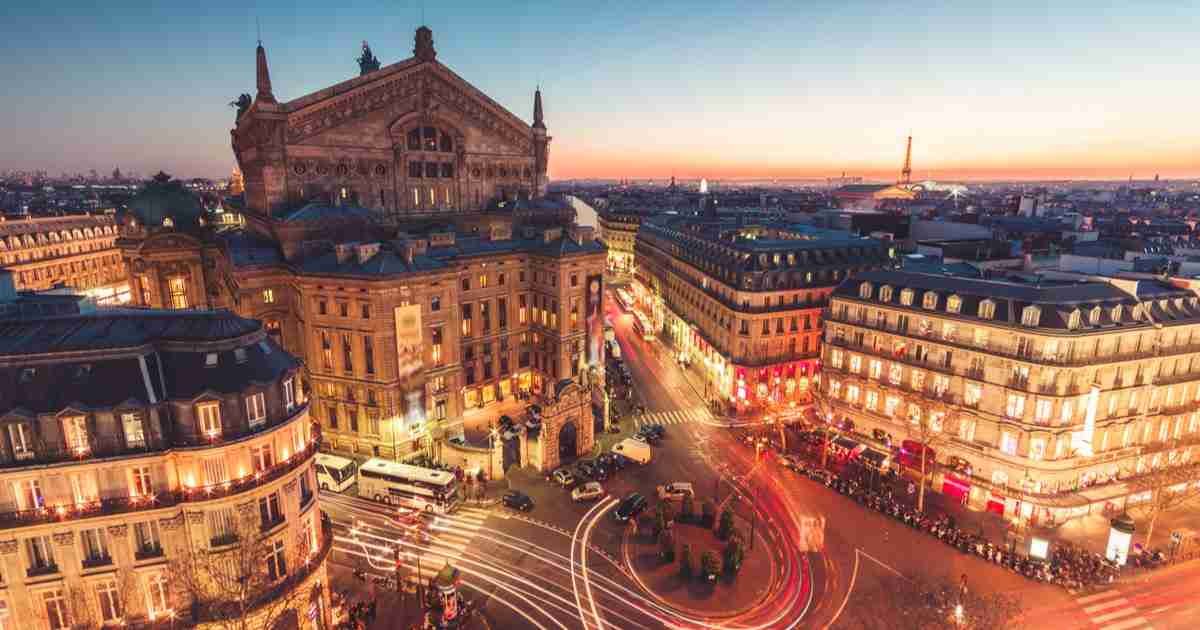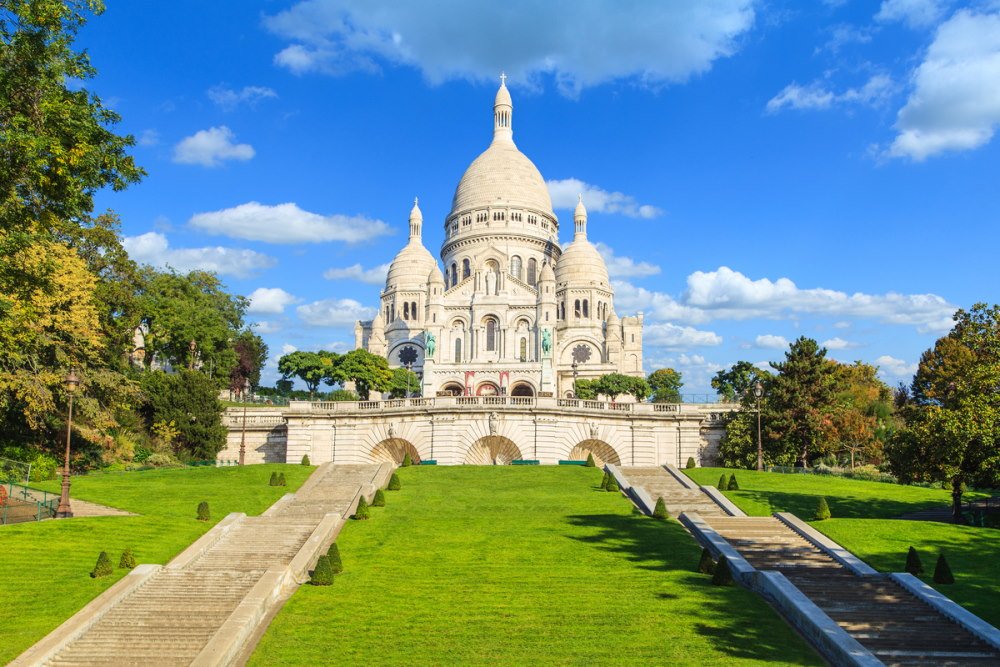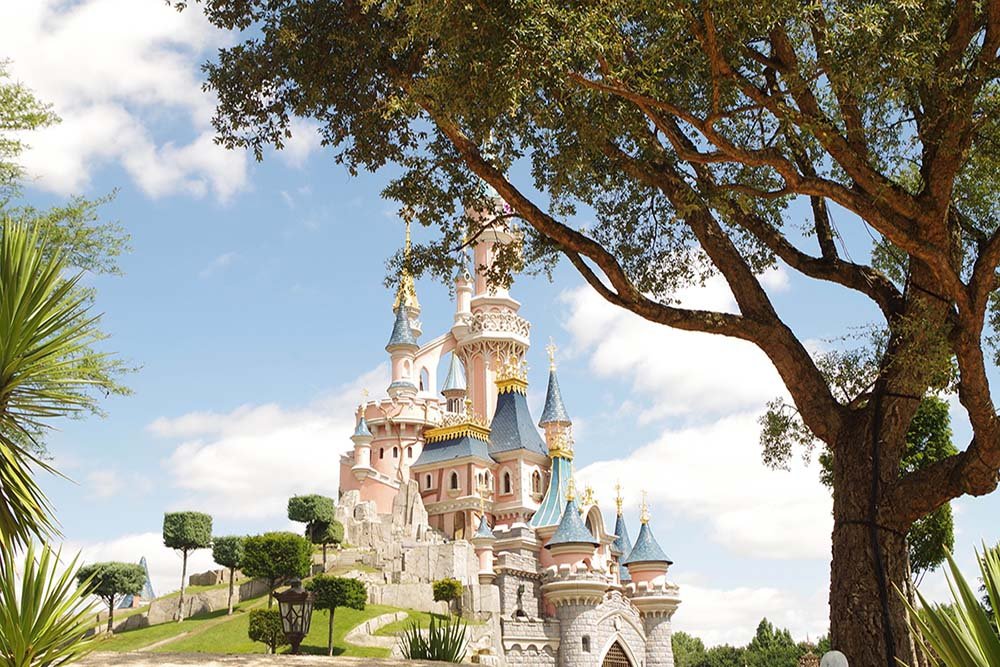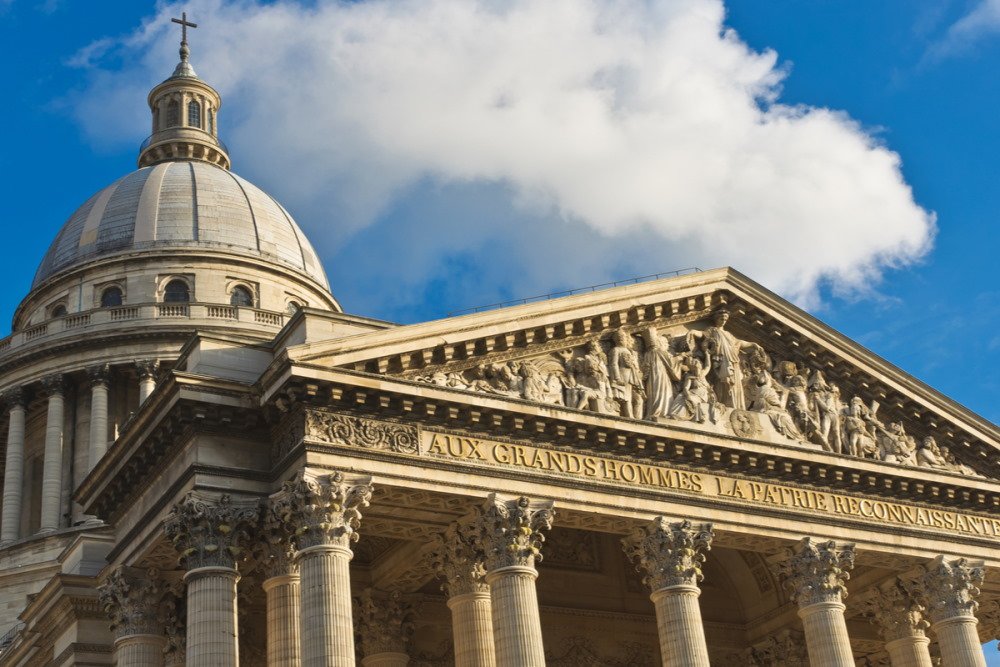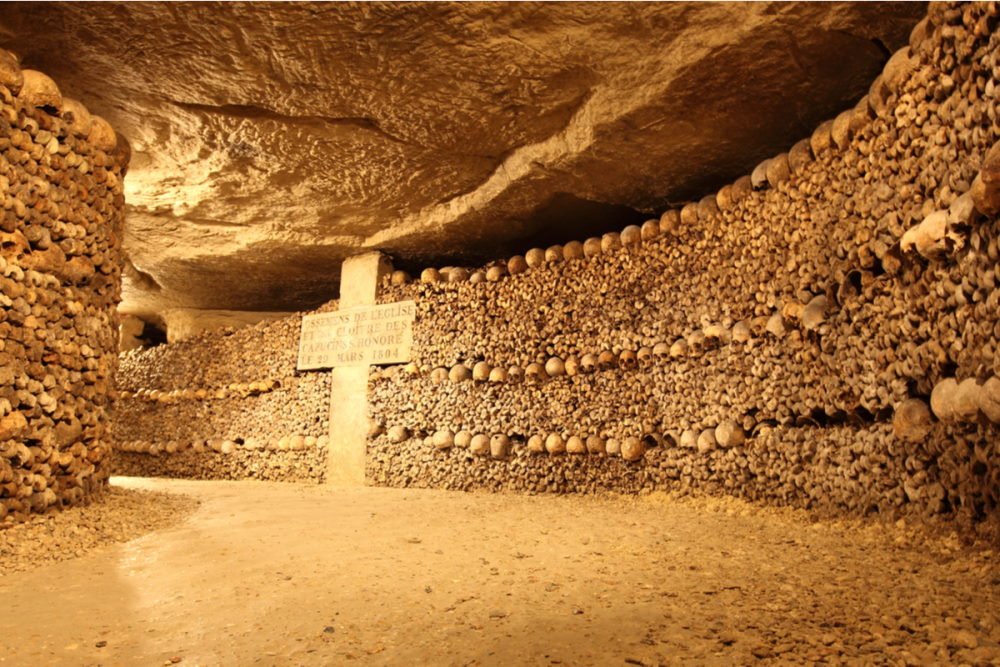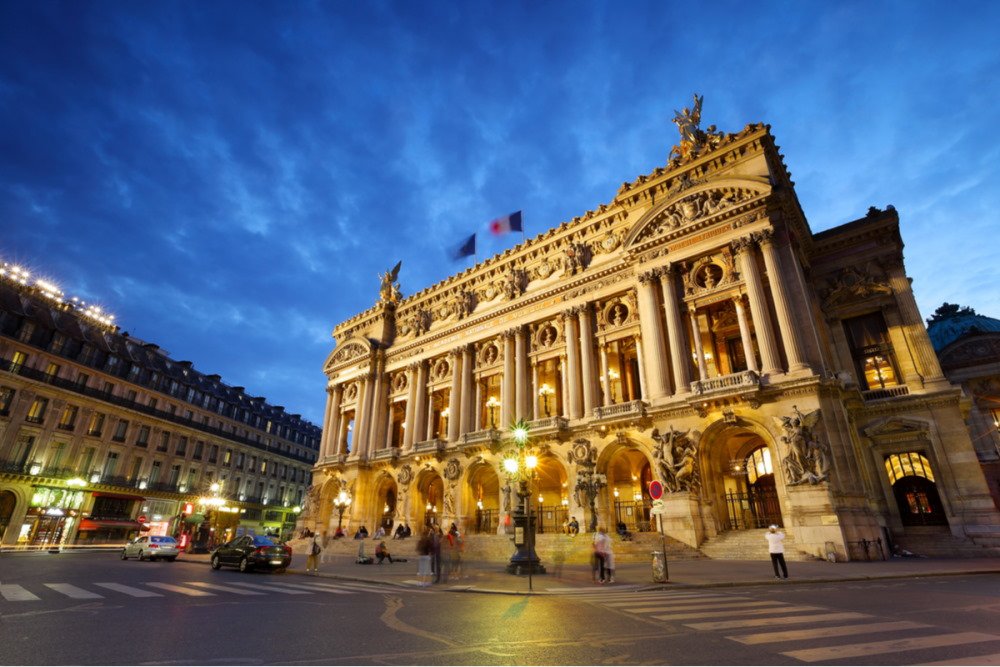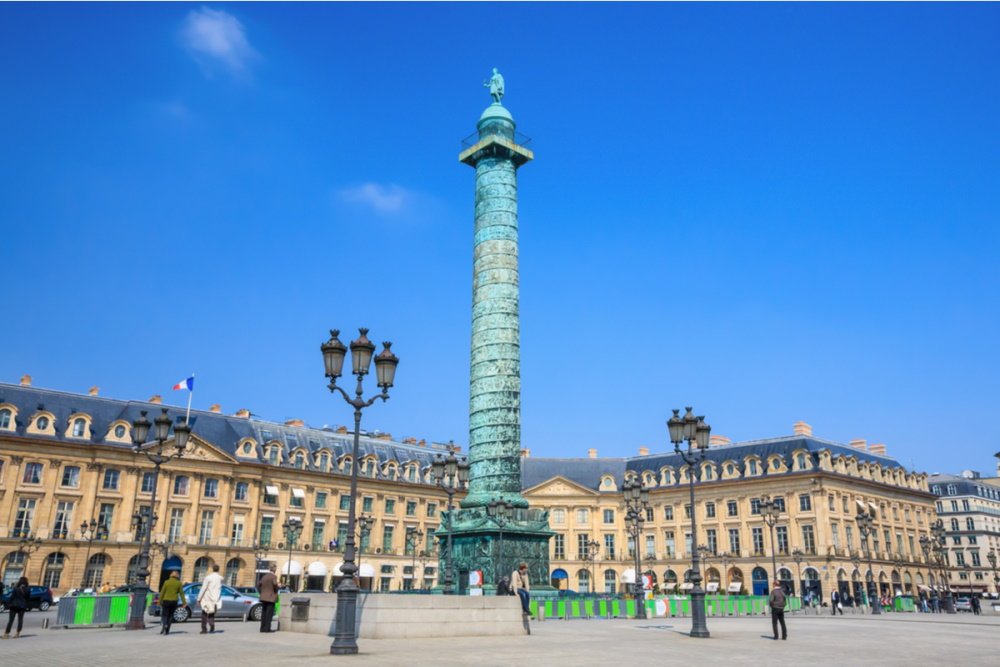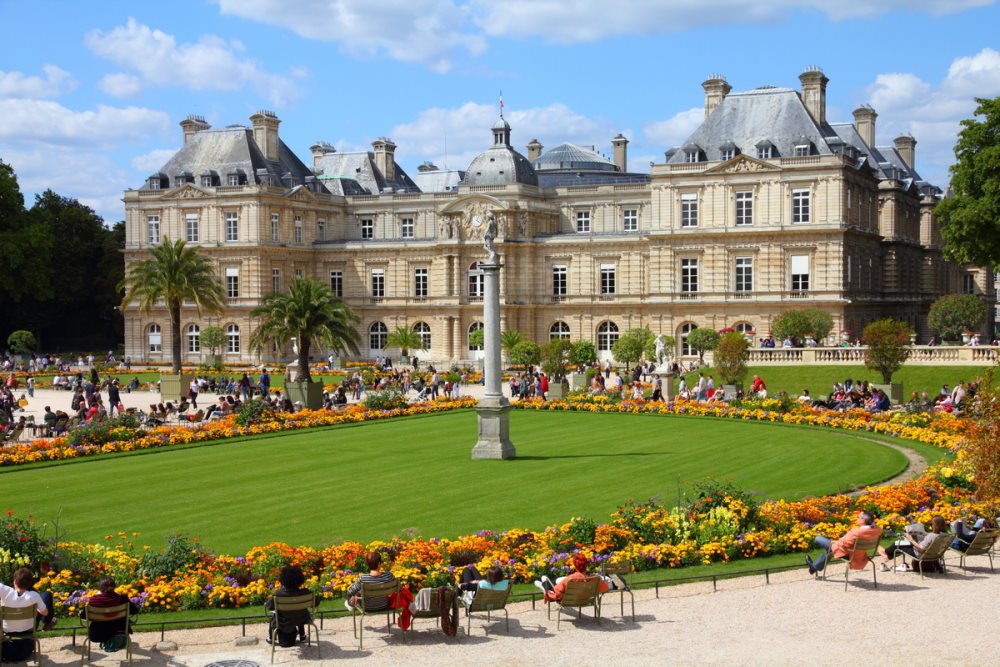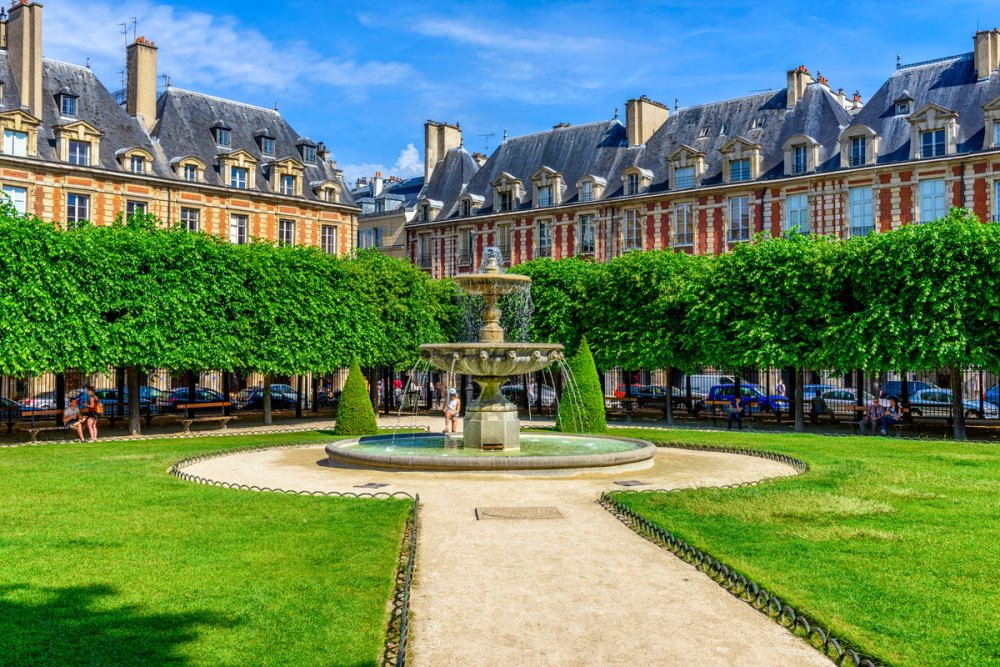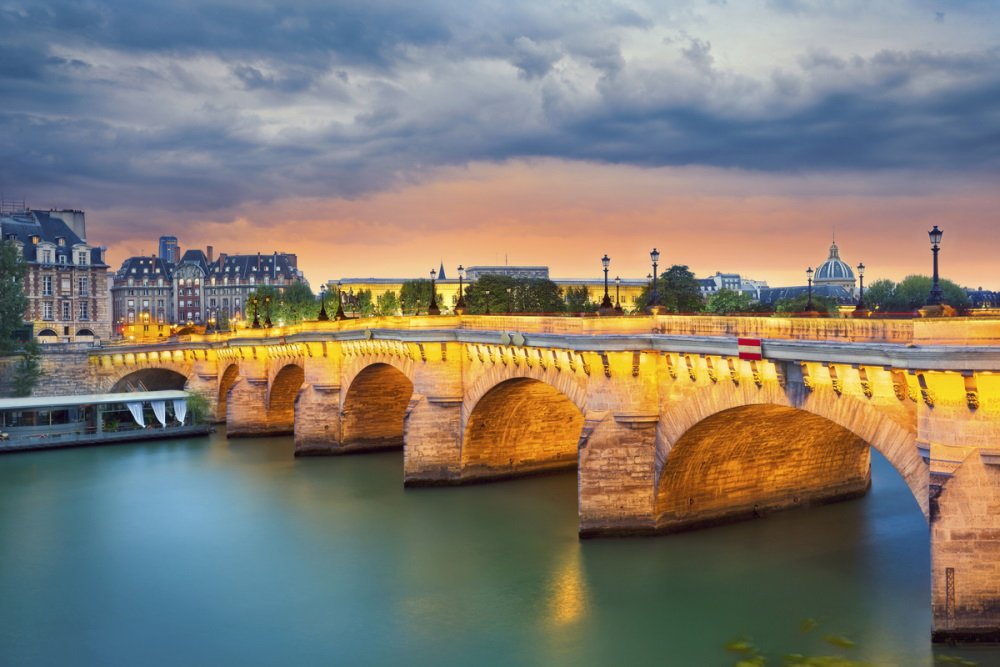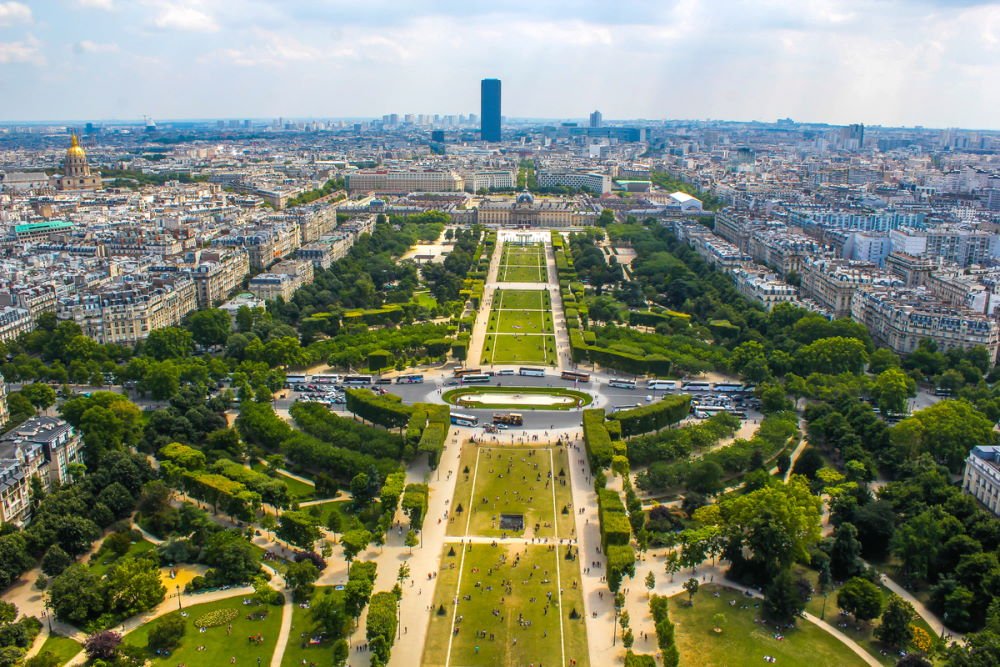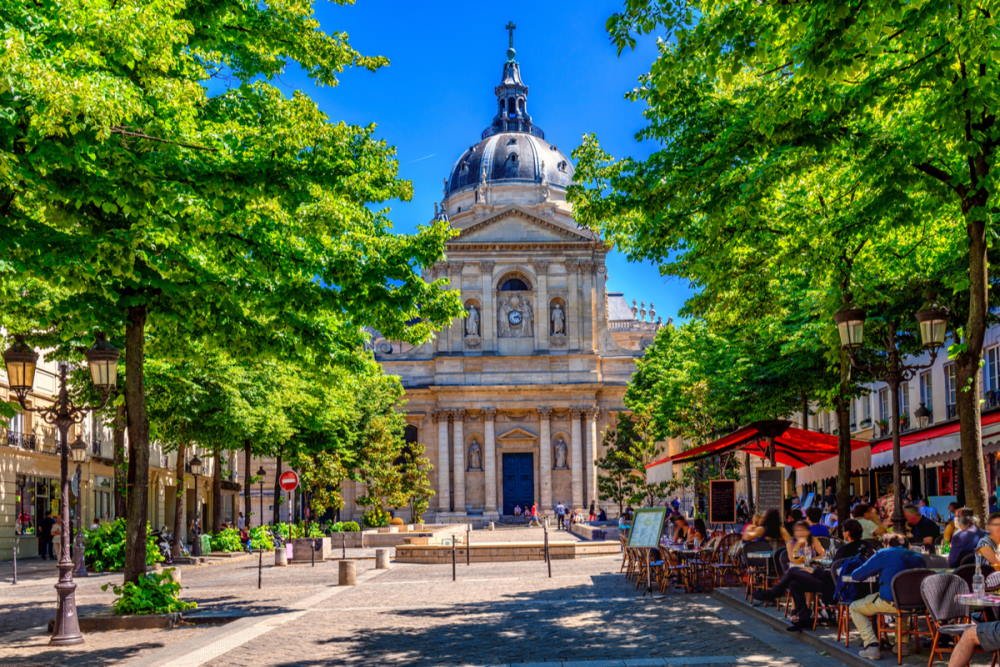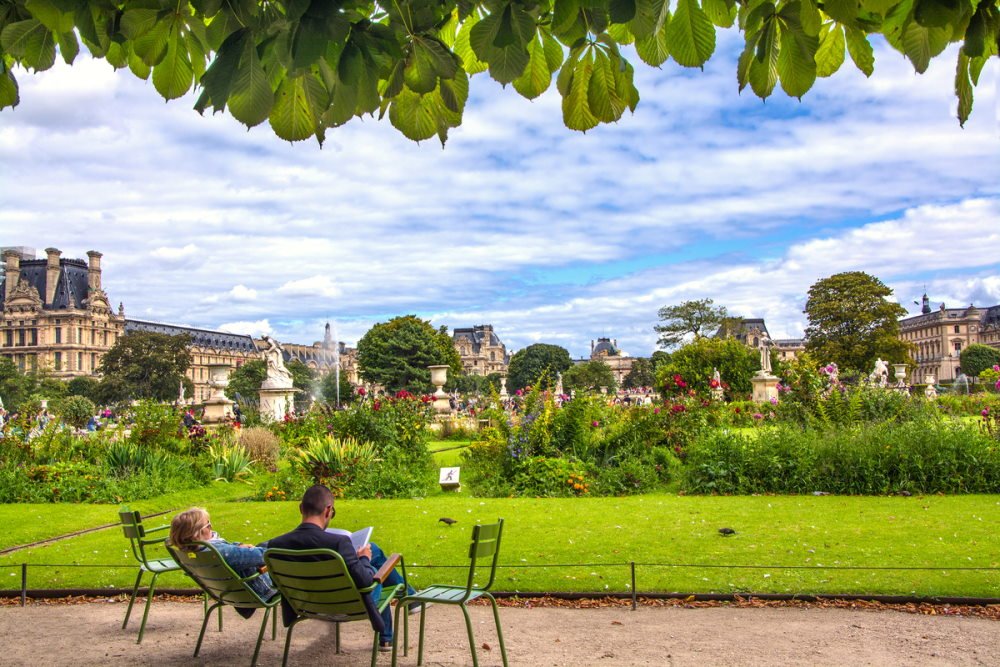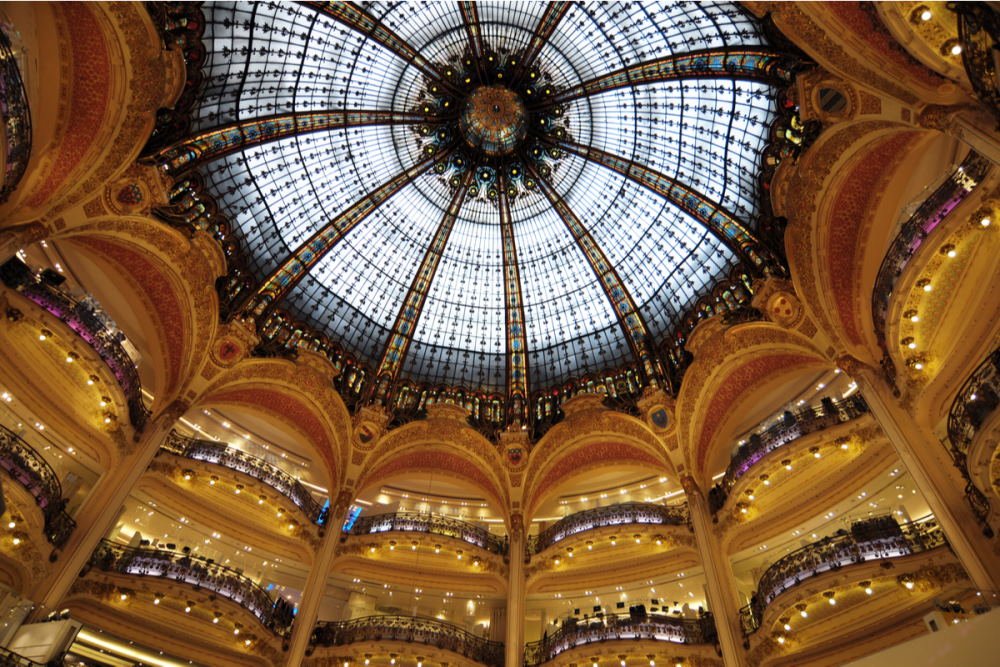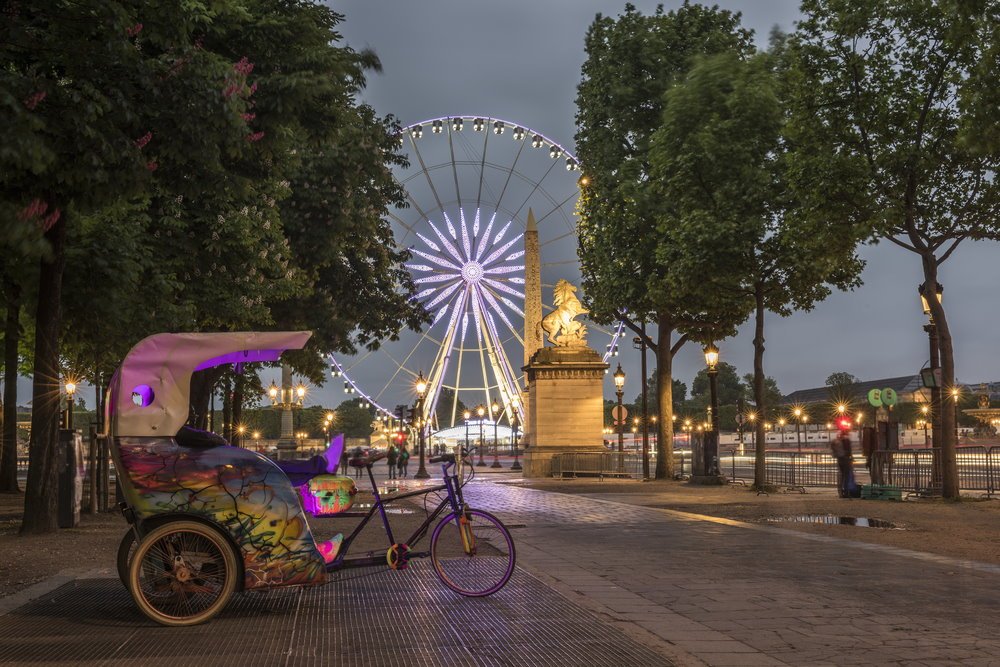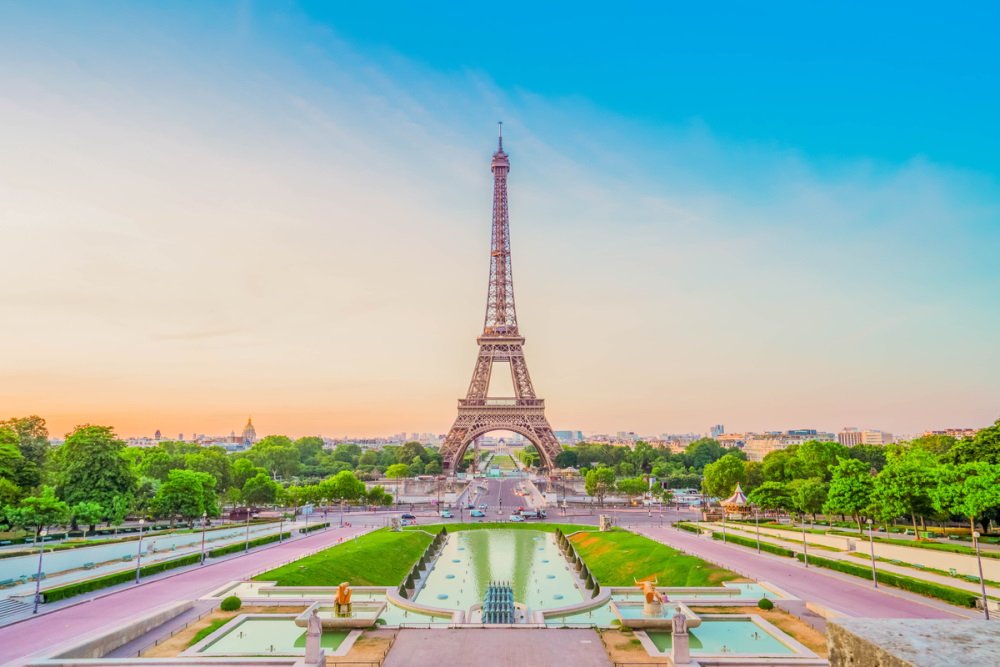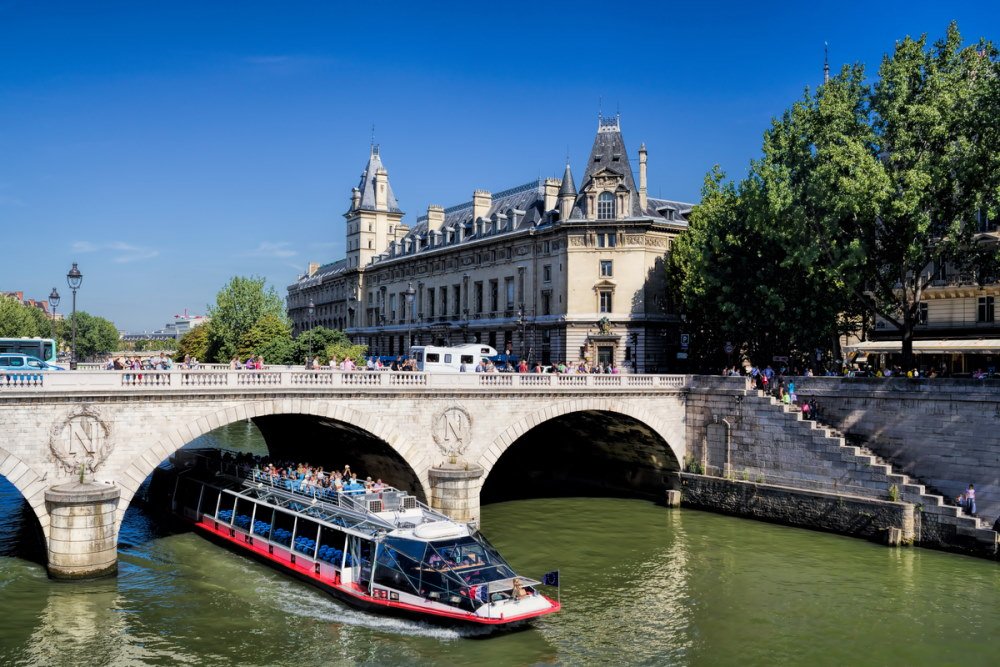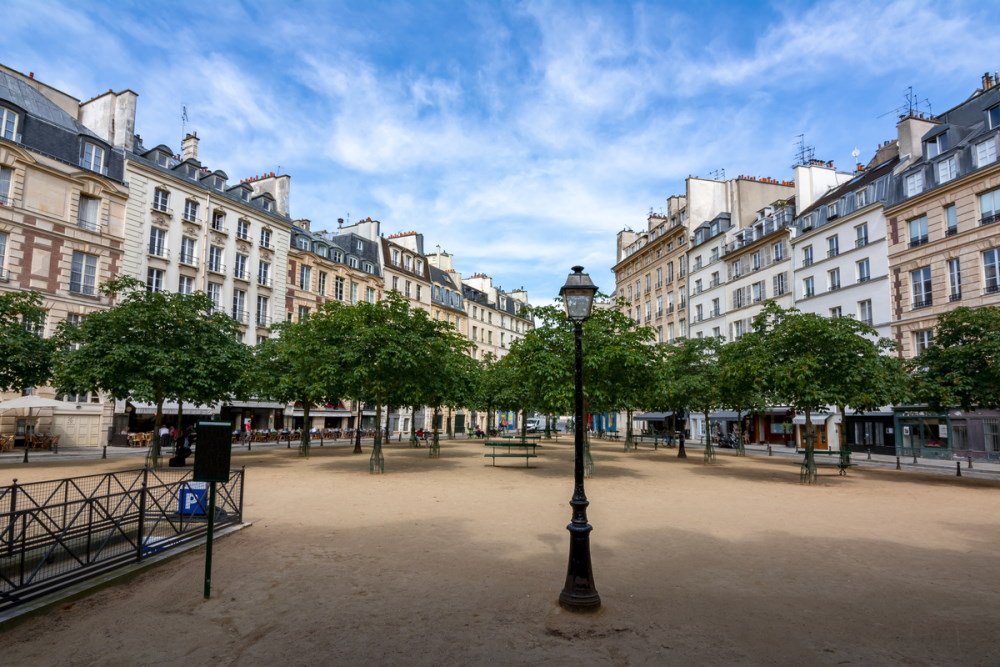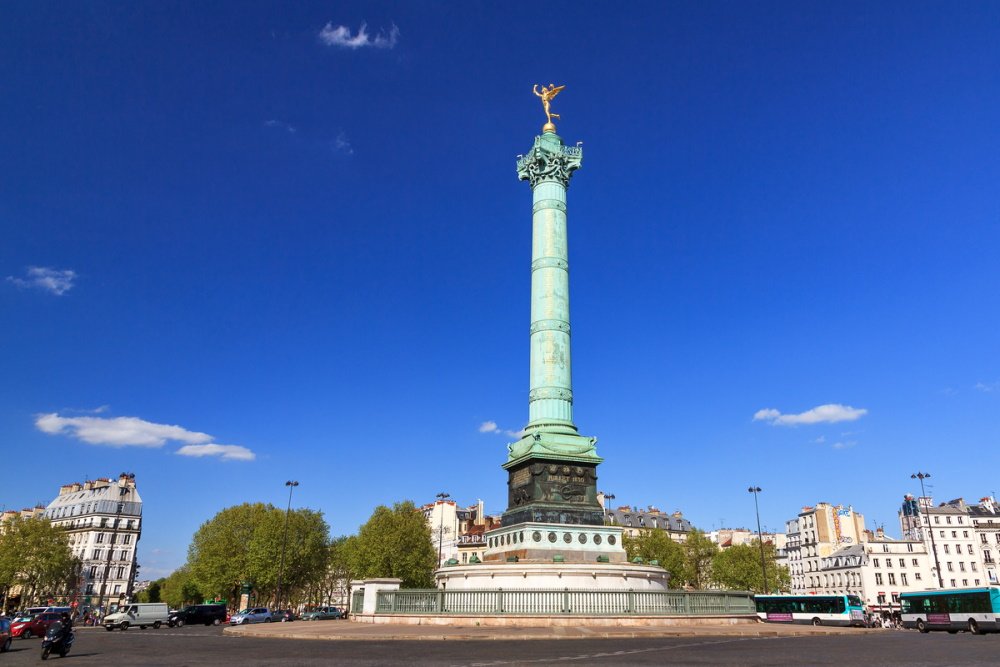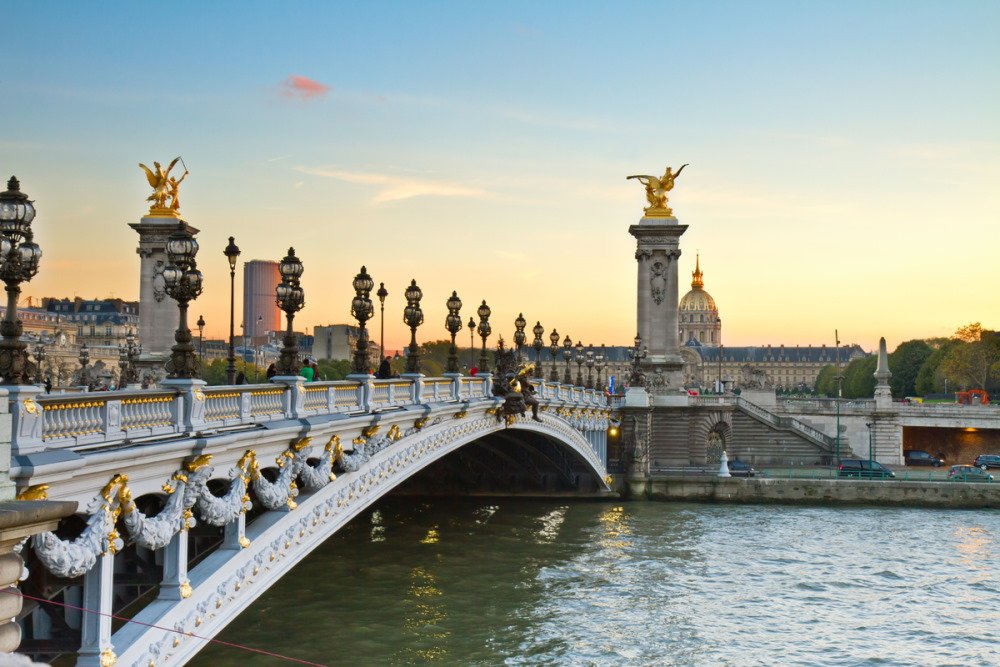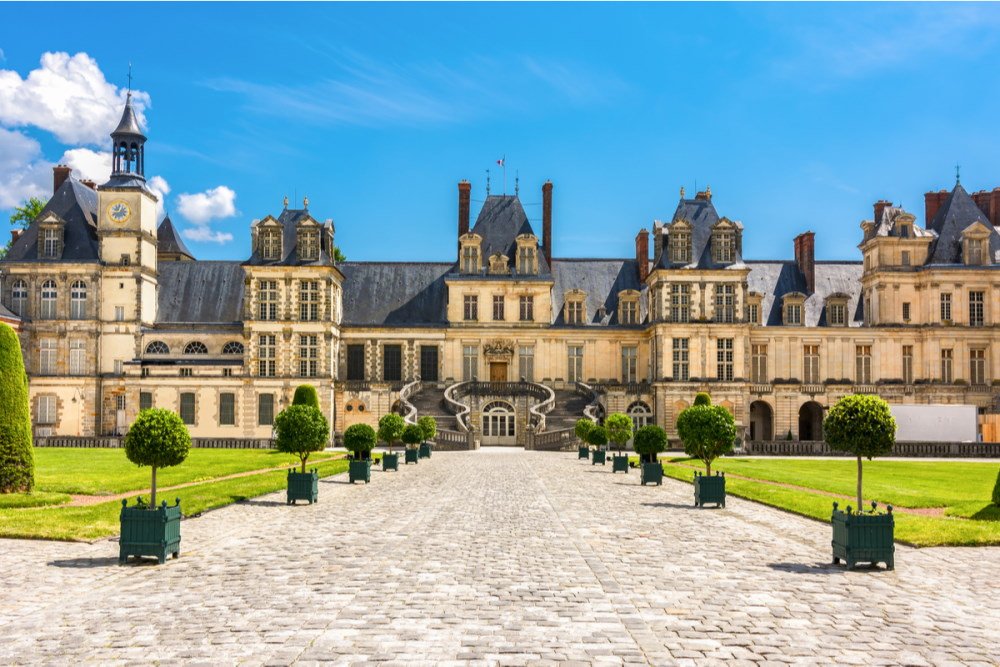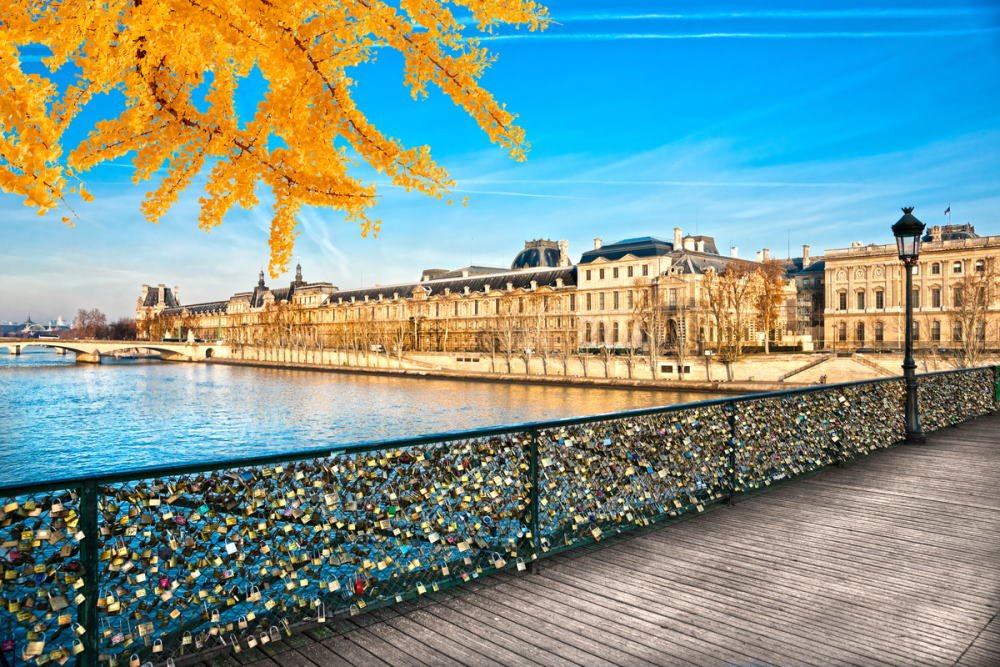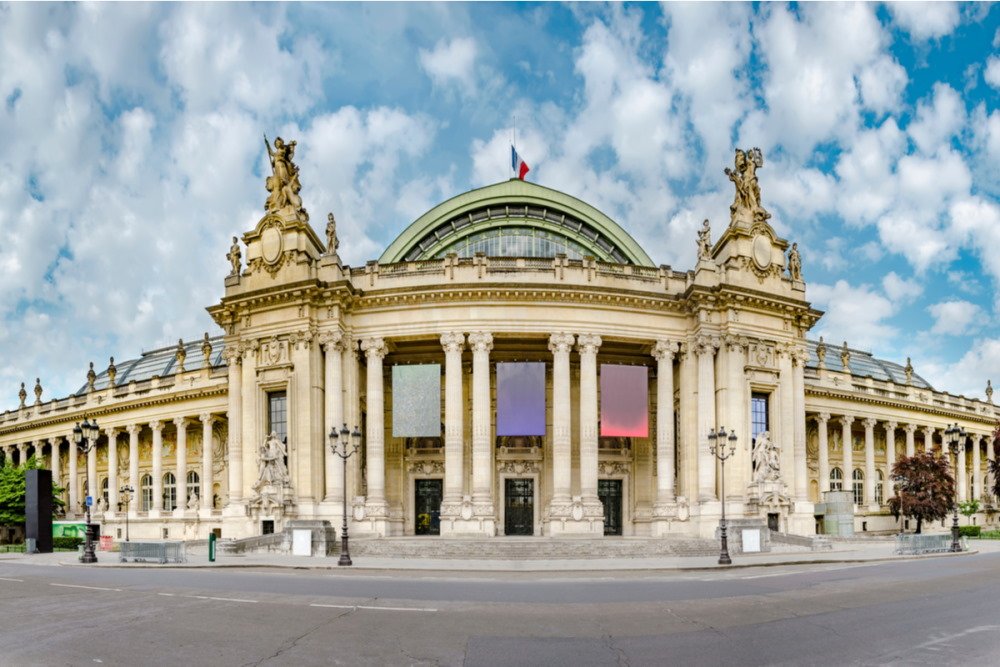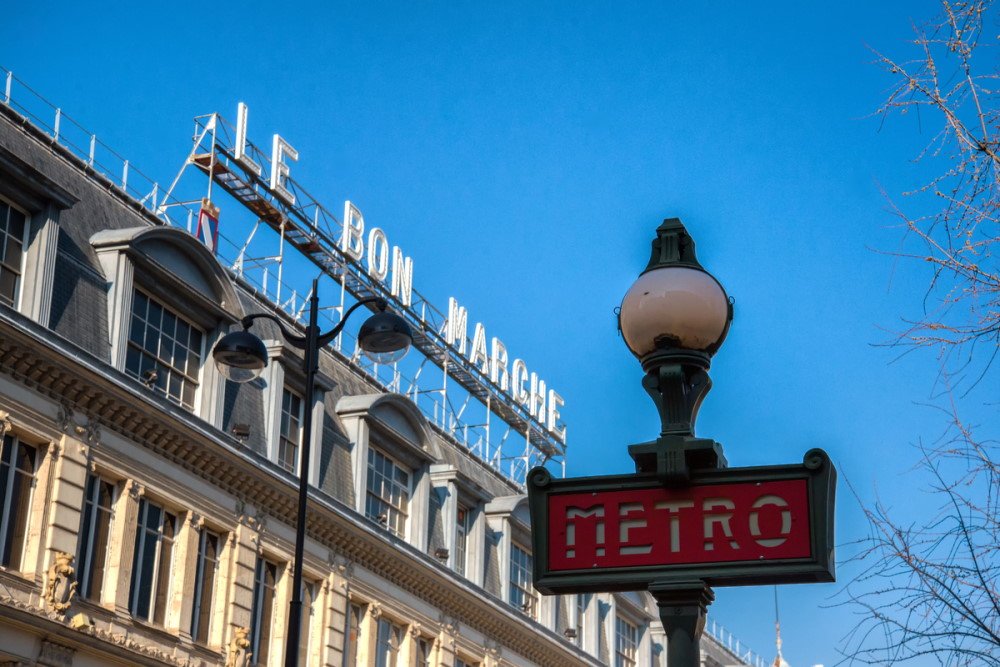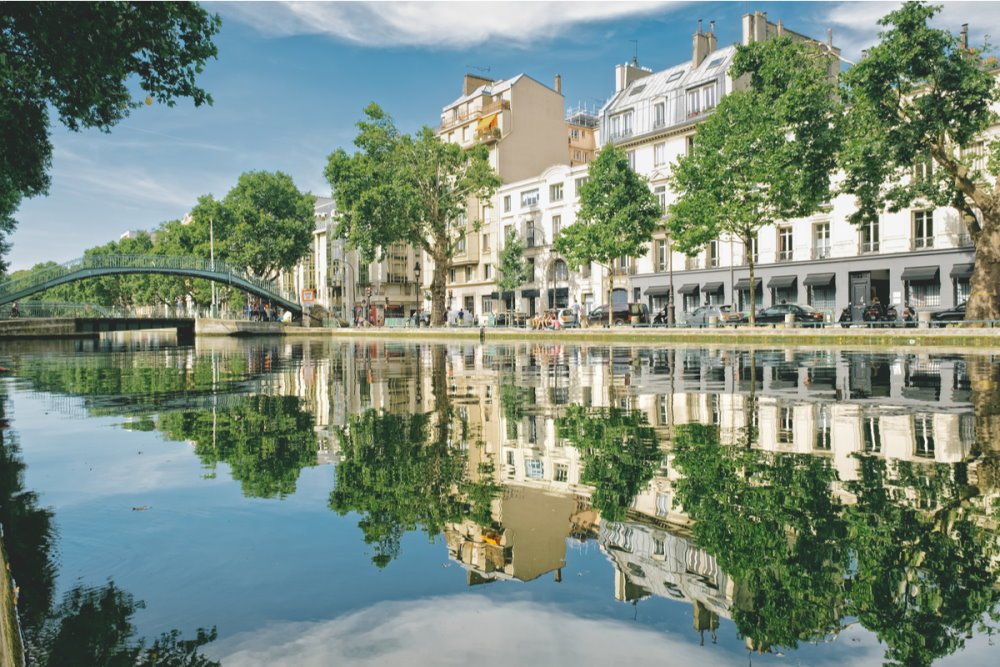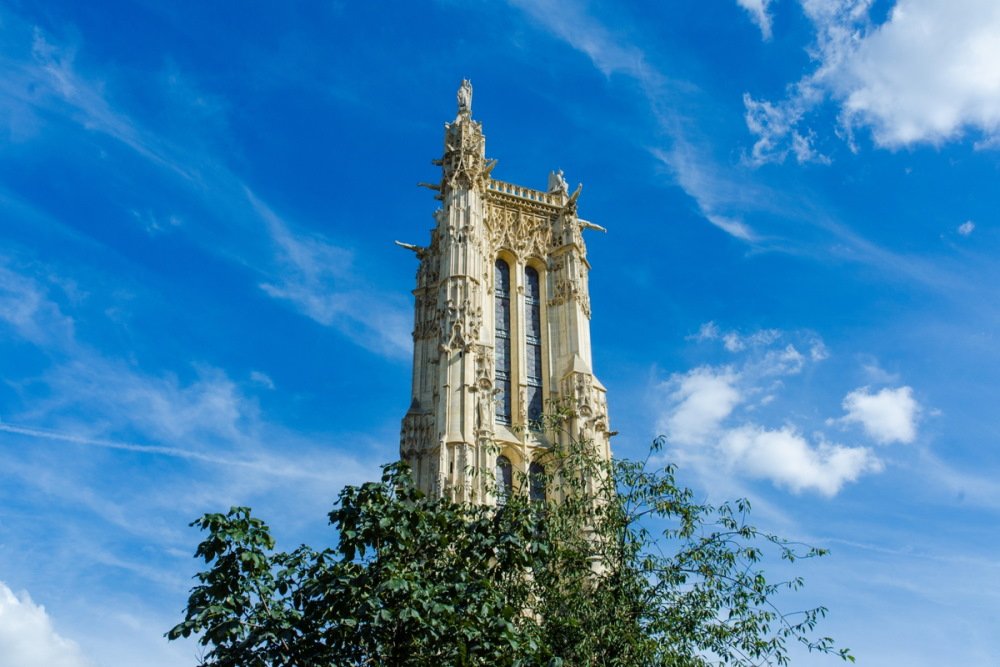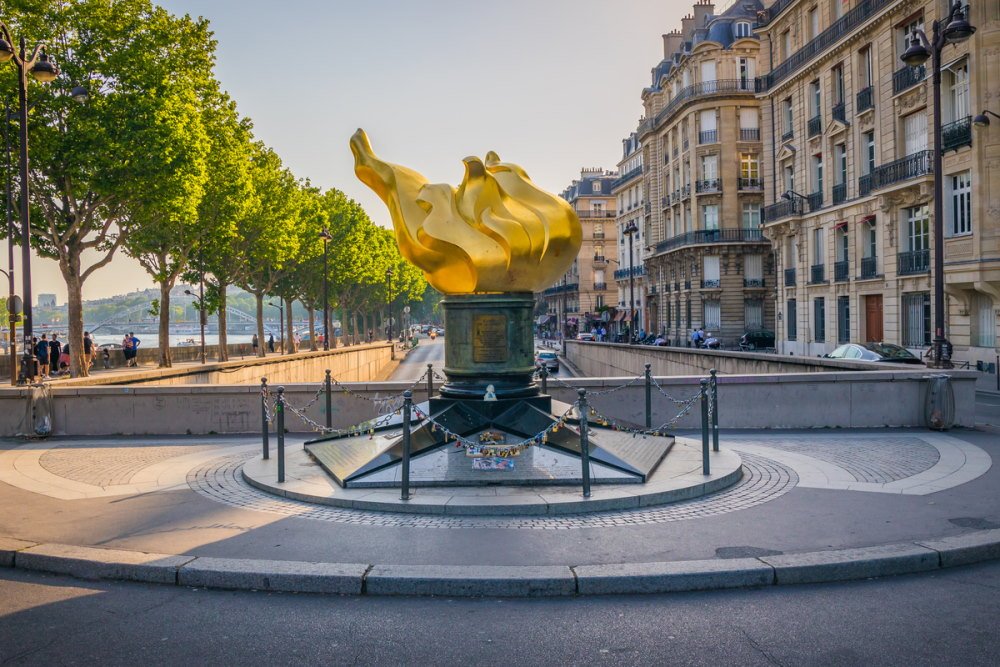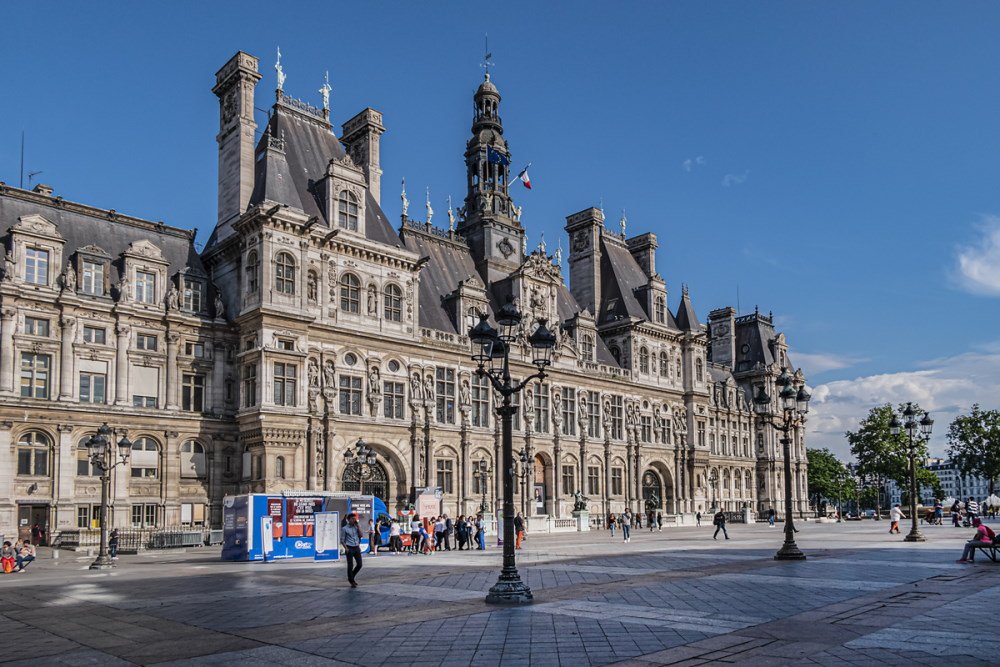Paris, the city of lights and love, is a maze of culture, history and extraordinary architecture. Every street, square and neighborhood reveals a new chapter of Parisian charm and romance.
With over two thousand years of history manifesting itself in every corner, Paris proudly holds the title of one of the most fascinating cities in the world.
From iconic masterpieces like the Eiffel Tower and the Louvre to lesser-known but equally stunning gems like the Sainte-Chapelle or the hidden streets of Montmartre, Paris offers endless opportunities for discovery.
In this article, we present you the 60 best things to do in Paris. Whether you're a history buff, art connoisseur, foodie or just a passionate traveler, you're guaranteed to find fascinating places that will instantly capture your heart.
Your personal Paris guide on your phone!

Discover Paris at your
own pace with our
self-guided audio guides.
Download and install the app,
buy a cheap tour, conquer Paris!

1. Eiffel Tower

The Eiffel Tower is the unmistakable symbol of Paris and towers a proud 324 meters above the City of Light and Love. Almost 300 million people have visited it since it opened. This makes the "Iron Lady", as the Eiffel Tower is affectionately known, the most visited paid monument in the world.
Built by the renowned engineer Gustave Eiffel and his team to celebrate the 1889 Universal Exposition and the centenary of the French Revolution, the Eiffel Tower embodies the technological genius and artistic elegance of the late 19th century and for 44 years held the title as the tallest structure in the world inside.
The icon has a firm place in the history and culture not only of France but of the entire world and is present in every feature film shot in Paris, in every documentary and travelogue about the city.
A visit to Paris would not be complete without climbing the metal giant, or at least getting up close and personal with the majestic tower. Whether by day or in full light at night, its sight fascinates and enchants anew.
Nearest metro stations
Line 6: Station Bir-Hakeim and 7 minutes on foot
2. Louvre Museum

A jewel on the banks of the Seine in the heart of Paris, the Louvre Museum is one of the largest and most famous art museums in the world. With over 9 million visitors annually, it is also the world's most visited museum.
It houses an impressive collection of over 380,000 works of art, of which 35,000 are on permanent display. The collection includes works from different eras and cultures, including Egyptian, Greek and Roman antiquity as well as Western European art from the Middle Ages to the 19th century. Among the best-known works are da Vinci's Mona Lisa and the Venus de Milo.
An architectural masterpiece, the Louvre was originally built in the 12th century as a fortress and residence for the French kings before being turned into a museum in 1793. The entrance building in the form of a glass pyramid was only added in 1989 and has since symbolized the connection between history and modernity.
If you are an art lover, you absolutely must visit the Musée du Louvre and reserve a full day if possible, but at least a few hours.
Nearest metro stations
Lines M1, M7: Palais-Royal/Musée du Louvre station and a 2-minute walk
Line M14: Pyramides station and a 6-minute walk
3. Notre-Dame Cathedral
The Notre Dame de Paris Cathedral, an architectural masterpiece of Gothic architecture, is located in the heart of the city on the Île de la Cité. It was completed in 1345 after almost 200 years of construction.
The impressive architecture of the cathedral, but above all its filigree rose windows enchant visitors from all over the world. It was one of the first places of worship to use cantilever buttress and rib vaulting techniques in its construction. Her famous gargoyles and grotesque sculptures are a real eye-catcher and stimulate the imagination of every viewer.
Inside the majestic church, which has been a silent witness to many important historical events in France, you can admire the massive organ with its 8,000 pipes, the impressive choir stalls and the mighty transept. From the observation decks of the two towers, you have a wonderful view of downtown Paris.
An essential part of the French capital's cultural and historical heritage, the Notre Dame Cathedral is a magnet for pilgrims and tourists alike.
Nearest metro stations
Line M4: Saint-Michel/Notre-Dame or Cité stations and a 4-minute walk
Lines M1, M11: Hôtel de Ville station and a 6-minute walk
Line M10: Cluny La Sorbonne station and a 7-minute walk
4. Sacre Coeur Basilica & Montmartre
Towering majestically atop Montmartre, the city's highest point, the Sacré-Cœur Basilica is both an impressive religious and architectural landmark.
Construction of this Byzantine-Romanesque church began in 1875 as a sign of national repentance after the Franco-Prussian War and the Paris Commune and was completed in 1914.
Sacré-Cœur, meaning Sacred Heart, is characterized by its stunning white façade. It owes its radiant white tint to the special Château-Landon stone, which becomes whiter and whiter with the effects of rain. With this striking appearance, the basilica is an unmistakable element of the Parisian skyline.
The basilica got its name because it is dedicated to the Sacred Heart of Jesus. This love is manifested in the chorus through a huge Christ mosaic. The great organ and the crypt, which is one of the largest in the world, are also impressive.
Visitors can climb the 270 steps to the dome for spectacular 360-degree views of Paris. The largest church bell in France and the eighth largest in the world hangs in the bell tower, weighing over 18 tons.
Montmartre is the district of Paris dedicated to Bohemian life, art, dreams and fairy tales. Even after more than 2 millennia, the highest part of the city resembles a small village, which is characterized by winding cobbled streets and rustic houses.
Many Paris tourists come here because the former village has lost none of its old charm and has many attractions that you will also like.
- By the way: The world-famous Moulin Rouge revue stage at Pigalle is located at the southern end of Montmartre. Check the best cabaret show ticket options, and buy your ticket in advance!
- For everything you need to know about the church and the Bohemian quarter, see our Sacré-Cœur Basilica and Montmartre articles.
Nearest metro stations
Line M7: Anvers station and a 7-minute walk
Line M12: Abbesses or Lamarck-Caulaincourt stations and an 8-minute walk
Line M4: Château Rouge station and a 10-minute walk
5. Orsay Museum
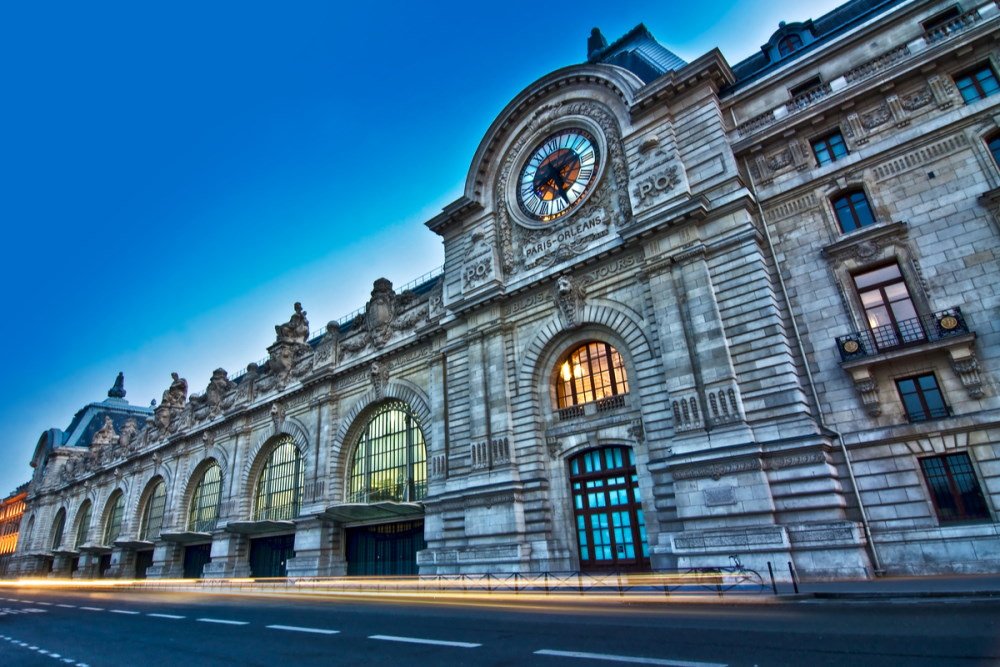
Opposite the Tuileries Gardens, on the south bank of the Seine, the Musée d'Orsay was originally built as a train station and opened as such in 1900. The Paris-Orléans railway line ended here.
The handsome building was converted into a museum in 1986 and has since housed an unrivaled selection of paintings and sculptures showing the emergence of modern art between 1848 and 1914. The collection begins where the Louvre ends.
The main genre is Impressionism and Post-Impressionism, but there are also works of Academism, Symbolism, and Primitivism. Visitors can admire masterpieces by artists such as Monet, Renoir, Van Gogh, Matisse, Rodin and Degas. Alongside the paintings and sculptures, there are also photographs, furniture and other art forms from the same period on display.
With its light-filled central atrium and stunning glass hall, the building's architecture is as impressive as the art it houses. The Musée d'Orsay is a true gem and a must for any art lover visiting Paris.
Nearest metro stations
Line 12: Solférino station and 4 minutes walk
6. Palace of Versailles
A stunning 17th-century masterpiece, the Palace of Versailles was inscribed on the UNESCO World Heritage List in 1979. The estate is one of France's most recognizable landmarks and a testament to the absolute monarchy of the Ancien Régime.
Versailles Palace was built during the reign of the Sun King Louis XIV. built and served as a royal residence until the French Revolution.
Inside the castle, visitors can explore a number of sumptuous rooms and drawing rooms, including the famous Hall of Mirrors, an impressive gallery of 357 mirrors reflecting the opposite windows.
The château is an important historical site as it was here that the Peace of Paris was signed in 1783, the proclamation of the German Empire in 1871 and the Treaty of Versailles in 1919 which ended the First World War.
The attached Garden of Versailles is equally impressive. Spread over 800 hectares, it is known for its geometric patterns of flower beds, spacious avenues, spectacular fountains and ornate statues.
The garden also houses the Grand Trianon, a smaller palace that served as the king's private retreat, and the Petit Trianon, which belonged to Marie Antoinette.
Nearest metro stations
Palace of Versailles is outside of Paris and is not connected to the metro network.
Versailles-Château-Rive Gauche is the train station closest to the château, about a 15-minute walk away. You can reach it with the RER line C, which departs from the Paris stations of St-Michel, Musée d'Orsay, Invalides, Pont de l'Alma and Champs de Mars-Tour Eiffel, among others. The journey takes 25 to 45 minutes, depending on which station you leave from.
7. Arc de Triomphe d'Etoile & Champs Elysees
The Arc de Triomphe d'Étoile is one of the most famous monuments in the French capital. Napoleon Bonaparte had it built in Rome in 1806 in the style of the Arch of Titus to commemorate the victory of his army in Austerlitz against the allied armies of Austria and Russia. However, it took 30 years for the work to be completed in 1836.
At 50 meters high and 45 meters wide, the arch towers majestically over Place Charles de Gaulle, once called Place de l'Étoile, hence the name. Twelve major streets intersect at the square, arranged in a star shape.
The walls of the Arc de Triomphe are carved with the names of over 500 French generals and great victories. Beneath the arch lies the Tomb of the Unknown Soldier from World War I, a permanent reminder of those who fell in the war.
From the roof of the arch, visitors have a breathtaking view of the Champs-Élysées and the surrounding area.

The Avenue des Champs-Élysées is perhaps the most famous street in the world. The majestic avenue, 70 meters wide, stretches for almost two kilometres and connects the Place de la Concorde to the Arc de Triomphe d'Étoile.
The name Champs-Élysées means "Elysian Fields" in English. According to Greek mythology, the souls of heroes and the righteous lived there after death.
The Champs-Élysées are synonymous with style and elegance. Luxury boutiques, upscale restaurants and cafes as well as cinemas line the boulevard. No wonder the avenue is frequented by more than 300,000 people every day.
During the summer, the Elysian Fields are transformed into an outdoor event space with concerts, exhibitions, parades or sporting events finishing the famous Tour de France. In winter, it shines in a sea of lights and becomes the magical backdrop for the Christmas market and New Year's Eve celebrations.
We recommend starting your stroll from the Arc de Triomphe and strolling along the left sidewalk to Place de Concorde. Soak up the atmosphere; it is a unique experience!
Nearest metro stations
Arc de Triomphe de l'Étoile and north-west start of the Champs-Élysées
Lines M1, M2, M6: Charles de Gaulle-Étoile and 2 minutes' walk
Line M4: Station Kléber and 10 minutes' walk
8. Disneyland Paris
This famous attraction is definitely high on the list of things to do in Paris for kids, and possibly for adults too.
The most visited theme park in Europe is also one of the 10 most popular destinations for Parisians and tourists who stay there.
The world-famous attraction on the outskirts of Paris consists of two theme parks, Disneyland® Park and Walt Disney Studios®, which offer countless rides, shows, events and parades over an area of 2000 hectares.
Whether Disney characters, roller coasters or haunted houses, Disneyland® Paris makes both little princesses and adrenaline junkies happy.
The large Disney complex just outside the city also includes several resort hotels, shopping, dining and entertainment venues, as well as a golf course and recreational facilities.
- Find out more about the popular theme park in our Disneyland® Paris article.
- To spend a special weekend in this fairytale atmosphere and enjoy the nightly show, book one of the best hotels around Disneyland® that we have listed for you.
- Check out your Disneyland® Paris ticket options online and book in advance.
Nearest metro stations
Palace of Versailles is outside of Paris and is not connected to the metro network.
Versailles-Château-Rive Gauche is the train station closest to the château, about a 15-minute walk away. You can reach it with the RER line C, which departs from the Paris stations of St-Michel, Musée d'Orsay, Invalides, Pont de l'Alma and Champs de Mars-Tour Eiffel, among others. The journey takes 25 to 45 minutes, depending on which station you leave from.
9. Seine Boat Tour
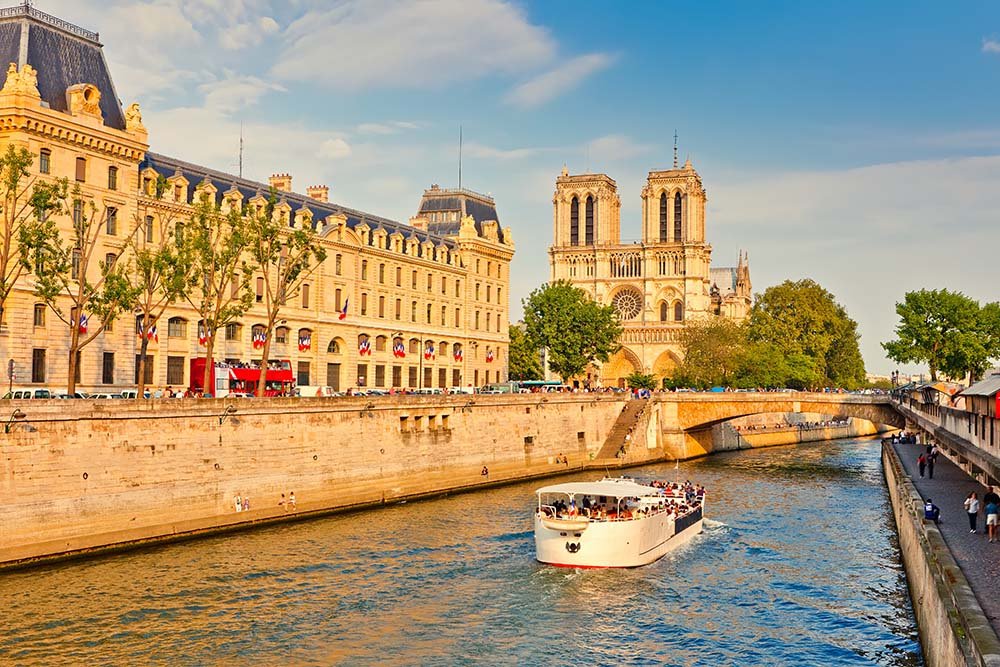
The Seine River Cruise is a great way to see Paris from a new perspective.
Whether it's a classic scenic cruise or a dinner cruise, the Seine River Cruise takes you past numerous sights while you relax on board and listen to the audio commentary.
For many Paris travellers, especially for those who are here for the first time and for families with children, it is an absolute highlight.
The tour is particularly romantic in the evening when the City of Lights is illuminated in the most beautiful colours.
10. Hop On Hop Off Bus

Among city travelers, one of the most popular ways to get to know a foreign city is the hop-on hop-off sightseeing tour, where you can hop off at any stop during the tour and hop back on later at the same or any other stop.
In Paris, not only buses follow this principle, but also boats on the Seine. This offers you the opportunity to get to know the French capital from the comfort of your seat on land and sea. And whenever you want to experience a sight up close, just hop off and continue later.
Apart from the fact that this way you will see more of the city than if you were to walk, it is also an ideal opportunity to meet people from other countries and exchange knowledge about the city during the trips.
- Find out more about this way of getting to know a city in our Hop On Hop Off Paris article.
- Check out your Hop On Hop Off Paris ticket options online and book in advance.
11. Pantheon
The Panthéon is a former church converted into a mausoleum dedicated to great figures in French history. The Panthéon takes its name from the ancient Roman temple that paved the way for later domed structures.
King Louis XV had the church built in the 18th century and dedicated it to Saint Genevieve, the patron saint of Paris. After its completion in 1790, during the French Revolution, the Revolutionary Assembly decided to turn it into a secular monument commemorating the great figures of national history.
A stunning example of neoclassical architecture, the walls inside the Panthéon are adorned with beautiful 19th and 20th century frescoes depicting important events in French history Earth rotation demonstrated.
The crypt beneath the Panthéon houses the tombs of some of France's most distinguished thinkers, writers and scientists, including Voltaire, Rousseau, Victor Hugo, Émile Zola and Marie Curie.
Nearest metro stations
Lines M10: Cardinal Lemoine station and 5 minutes' walk
Line M7: Place Monge or Jussieu stations and 8 minutes' walk
Line M4: Saint-Michel/Notre-Dame station and 9 minutes' walk
Your personal Paris guide on your phone!

Discover Paris at your
own pace with our
self-guided audio guides.
Download and install the app,
buy a cheap tour, conquer Paris!

12. Pere Lachaise Cemetery
Pere Lachaise is the most famous cemetery in the world. King Louis XIV had it laid out in 1804 and dedicated it to Père (father) François de la Chaise, his father confessor.
Because the cemetery was far from the city center, the concessions were too expensive, and the predominantly Catholic society felt disturbed by the secular regulations, few people were buried here at the time.
In later years, the local government wanted to stimulate interest in the cemetery. They relocated two iconic names in literature, Moliere and Jean de la Fontaine, to the unloved spot. The plan worked! Soon the remains of the tragic lovers Eloise and Abelard were buried along with 33,000 other people.
Later, personalities such as the poet Oscar Wilde, the singer Edith Piaf, the composer Frédéric Chopin or the Doors frontman Jim Morrison found their final resting place. The tombs vary from plain stone slabs to impressive mausoleums and monumental sculptures, and tell the story of more than two centuries.
With its tree-lined avenues, wild flower gardens and countless birds, the cemetery offers a tranquil, almost pastoral atmosphere in the midst of the hustle and bustle of the city. At the Père Lachaise, take a fascinating journey through history and culture.
Nearest metro stations
Lines M2, M3: Père Lachaise station and 1 minute walk
Line M2: Philippe Auguste station and 3 minutes walk
Line M3: Gambetta station and 2 minutes walk
Line M9: Voltaire or Buzenval stations and 10 minutes walk
13. Moulin Rouge
Opened in 1889, the Moulin Rouge with its red windmill is not only one of the most famous landmarks in Paris, it is also considered the birthplace of the legendary can-can.
An extravagant cabaret show with unbelievable choreographies, breathtaking costumes and glamorous showgirls is presented every evening in an opulent theater hall.
If you like, you can crown your stay in Paris with an unforgettable revue in perhaps the most famous variety of theaters in the world with champagne or an evening meal.
Nearest metro stations
Line M2 Blanche station and 1 minute walk
Line M12 Pigalle station and 5 minutes walk
Line M13 Place de Clichy station and 5 minutes walk
14. Sainte Chapelle & Conciergerie

The Sainte-Chapelle, on the Île de la Cité in the heart of Paris, is a masterpiece of Gothic architecture and, along with the Conciergerie, one of the oldest surviving structures of the Royal Palace.
Built in the 13th century under King Louis IX. and completed in 1248, it originally served to house the sacred relics of the Passion of Christ, including the famous crown of thorns.
The chapel is particularly impressive for its fascinating stained glass windows, which depict more than 1,000 biblical scenes from the Old and New Testaments. When the sun's rays hit the colorful windows, the interior is bathed in a magical light.
Although relatively small, the Sainte-Chapelle leaves a deep impression on its visitors. Its sheer beauty and historical importance make it an essential stop for any visitor to Paris.
The Conciergerie, right next to the Sainte-Chapelle, is a significant site of French history and offers a deep insight into it.
It was part of the royal palace known as the Palais de la Cité before being converted into a prison during the time of the French Revolution, where ironically political prisoners such as royalty, including Marie Antoinette, were held before being sent to the guillotine were led. Today you can visit the Queen's former prison cell.

The Conciergerie also boasts remarkable Gothic architecture. The Hall of the Guards, one of the oldest surviving halls in Europe, is particularly impressive.
The clock tower on the northeast side of the building is worth seeing. The clock, installed in 1370, is one of the oldest public clocks in France and is an important example of medieval craftsmanship, testament to the technical skill and creativity of its creators.
- Also read our article Île de la Cité.
- Check out the best Sainte-Chapelle ticket options online and book in advance.
Nearest metro stations
Line M4: Cité station and 2 minutes' walk each
Lines M1, M7, M11, M14: Châtelet station and 5 or 7 minutes' walk
Line M10: Cluny La Sorbonne station and 8 or 10 minutes' walk
15. Catacombs of Paris
This attraction takes you to the subterranean depths of the city. The Catacombs of Paris in the Montparnasse district have been open to the public since 1874.
They house the bones of around 6 million people, who were excavated from Paris cemeteries at the end of the 18th century due to a lack of space and artfully laid out in the tunnel of a former stone work.
A tour of the approximately two-kilometer accessible section of the catacombs allows you to see this extraordinary arrangement of skulls and bones and gain a unique, and perhaps slightly macabre, glimpse into the history of Paris.
- For everything you need to know about the underground burial site, see our Paris Catacombs article.
Nearest metro stations
Lines M4, M6: Denfert Rochereau station and 2 minutes walk
16. Garnier Opera
Also known as the Palais Garnier, the Opéra Garnier was inaugurated in 1875 and is best known for its Beaux-Arts architecture. Built by the architect Charles Garnier, the opera house can accommodate more than 1,900 guests, who can attend mainly classical opera and ballet performances.
On this occasion, visitors can also admire the magnificent interior of the Opéra Garnier, which impresses with its imposing staircase, rich gold decorations and the ceiling painting by Marc Chagall in the opera hall.
The fact that the Opéra Garnier, declared a historic monument in 1923, was the inspiration for the famous novel The Phantom of the Opera makes it all the more worth seeing.
You can visit the opera house all year round, just make sure you are in your smartest outfit.
Nearest metro stations
Lines M3, M7, M8 Opéra station and 3 minutes walk
17. Hotel des Invalides

The Hôtel des Invalides, commonly known as Les Invalides, is an impressive complex built in the 17th century by order of King Louis XIV.
Originally it served as a home and hospital for aging and injured military veterans; a remarkable act of caring at a time when such facilities were rare.
Today, Les Invalides houses several museums and monuments related to France's military history. The Musée de l'Armée is one of the most important military museums in the world and houses one of the world's largest collections of military history.
You can also admire historical weapons and armor of war at the Musée des Plans-Reliefs and the Musée de l'Ordre de la Liberation.
Since 1840, Napoleon Bonaparte's remains have been kept in a red porphyry sarcophagus in the Dôme des Invalides, an impressive church topped by a golden dome and visible from afar.
The magnificent architecture and rich history make Les Invalides a very interesting destination of a Paris tour.
- Find out everything you need to know about what is perhaps the most famous street in the world in our article Army Museum & Tomb of Napoleon.
Nearest metro stations
Lines M1, M8, M12: Concorde station and 3 minutes walk
18. Le Manoir de Paris
A nerve-wracking horror spectacle awaits you in a listed building in Paris' 10th arrondissement.
The chamber of horrors, which opened in 2011, stages Parisian legends such as "Phantom of the Opera" or "The Hunchback of Notre-Dame" in an interactive performance with costumed actors who provide chilling moments.
A small-group walking tour takes you through the rooms of the haunted house, where the city's dark past and chilling myths are brought to life.
Goosebumps and entertainment at the highest level are guaranteed!
Nearest metro stations
Line M4 Gare d'Est or Château d'Eau stations and a 5-minute walk
Line M7 Poissonnière station and a 7-minute walk
Lines M8, M9 Bonne Nouvelle station and a 12-minute walk
19. Tour Montparnasse

The Tour Montparnasse is a skyscraper in the district of the same name. It is the second highest vantage point in the city after the Eiffel Tower and offers one of the best panoramic views of Paris. You can visit the panoramic floor on the 56th floor at 194 meters and the roof terrace of the skyscraper 16 meters higher.
Or you can round off a beautiful day in Paris with a dinner in the panorama restaurant Le Ciel de Paris, also on the 56th floor, and enjoy the wonderful view alongside the delicious dishes, preferably just before sunset.
- Learn more about the skyscraper in our Tour Montparnasse article.
- Check out your Tour Montparnasse ticket options online and book in advance.
Nearest metro stations
Lines M4, M6, M12, M13: Montparnasse Hall station 1-2 and 4 minutes walk
20. Jardin des Plantes

The Jardin des Plantes, the oldest botanical garden in Paris, stretches over 28 hectares and is a paradise for nature lovers and science buffs. Originally founded in 1626 as a royal medicinal herb garden, it has grown into an extensive collection of botanical species and a major research centre.
The "Garden of Plants" is home to several specialized gardens, including the Rose Garden, the Alpine Garden, and the remarkable Greenhouse, which displays an impressive collection of exotic plants from around the world. It also houses the Natural History Museum, which is divided into several galleries for evolution, paleontology, botany, mineralogy, and geology.
Another highlight of the garden is the Ménagerie, the oldest active zoological garden in the world, which is home to a variety of animals including red pandas, orangutans and snow leopards. A refreshing urban retreat, the Jardin des Plantes is a fascinating center for scientific discovery.
Admission to the botanical garden and its facilities is free.
- Discover even more popular parks in Paris.
Nearest metro stations
The Jardin des Plantes has several entrances.
Main entrance Rue Cuvier 47, 57
Lines M7, M10: Jussieu station and 5 minutes walk
Entrances at 36, 38, 40 rue Geoffroy-Saint-Hilaire
Line M7: Stations Place Monge or Censier-Daubenton and 4 to 6 minutes walk
Entrances at 2, 8, 10, 18 rue Buffon and Place Valhubert
M5 line: Quai de La Rapée and 5 to 8 minutes' walk
M7 line: Censier-Daubenton station and 8 to 10 minutes' walk
21. Parc Asterix

Located about 35 kilometers north of Paris, Parc Astérix has been delighting fans of the comic heroes Asterix and Obelix since 1989, created by French author René Goscinny and illustrator Albert Uderzo.
The theme park offers a variety of attractions geared towards both the younger visitors and those seeking thrills. It is divided into six themed areas based on different historical cultures and locations including Ancient Rome, Ancient Greece, the Vikings and of course the Gallic village of Asterix and Obelix.
Reflecting the playful nature of the comic books, the humorous and lively main attractions include thrilling roller coasters, water slides, carousels, live shows and interactive experiences. Highlights include one of the fastest wooden roller coasters in the world, the Hinkelstein water ride, and dolphins and sea lions.
Are you looking for a unique theme park experience on a sunny day? Then the Parc Astérix is an absolute must, especially if you have children with you...
- Read more about the theme park on the outskirts of Paris in our Parc Astérix article.
- Check out your Parc Astérix ticket options online and book in advance.
Nearest metro stations
Parc Astérix is not connected to the metro network. From Paris you have two cheap ways to get there.
- The shuttle buses from FlixBus or BlaBlaCar go directly to the amusement park and back from the Paris Bercy Seine bus terminal. A ride takes about 70 minutes. The bus terminal can be reached by metro M6 to Quai de La Gare and 9 minutes' walk or by metro M14 and 13 minutes' walk.
- You can take the RER B train, for example, from Saint-Michel/Notre-Dame, Châtelet-Les Halles or Gare du Nord to the final station Charles de Gaulle Airport and take the park's own shuttle bus from there. The total travel time without changing trains is 65 to 75 minutes, depending on how you board at the stations mentioned above.
22. Aquarium de Paris - Cineaqua

The Aquarium de Paris, also known as Cinéaqua, is a spectacular underwater experience in the Trocadéro Gardens across the Seine from the Eiffel Tower and features a variety of marine life including more than 10,000 fish and invertebrates from around the world.
The aquarium extends over two levels over 3,500 square meters and includes a total of 43 tanks that represent the different ecosystems of the sea.
The main attractions include the tank with an impressive variety of shark species, as well as the touch tank, where visitors have the opportunity to touch rays and other sea creatures.
But Cinéaqua is not just an aquarium. It also houses two cinema halls that show underwater-themed films.
- For more information on the Cinéaqua, see our Aquarium de Paris article.
- Check out your Aquarium de Paris ticket options online and book in advance.
Nearest metro stations
Line M9: Trocadéro or Iéna stations and a 5-minute walk
Line M6: Trocadéro station and a 5-minute walk
23. Atelier des Lumieres

The Atelier des Lumières, in English Atelier des Lichts, can not only come up with a completely new look at art itself, but also with a very special kind of experience.
Housed in a former foundry in the 11th arrondissement, it presents masterpieces by different artists through larger than life and imposing video and light projections, most recently Van Gogh and Gustav Klimt.
The spectacular spectacle, which allows visitors to immerse themselves in the works of art, attracts up to half a million people every year.
- You can find out more about the workshop of light in our article Atelier des Lumières.
Nearest metro stations
Line M3 station Rue Saint-Maur and 5 minutes walk
Line M9 stations Voltaire or Saint-Ambroise and 7 minutes walk
Line M2 station Père Lachaise and 8 minutes walk
Line M5 station Richard Lenoir and 10 minutes walk
24. Crazy Horse

In the heart of Paris lies the famous Cabaret Crazy Horse, a glittering icon of Parisian nightlife that has been delighting the city with its unique and artistic performances since 1951.
Known for its avant-garde and sensual shows, Crazy Horse places female beauty and grace at the center of its performances. Each show is a perfect composition of light, music and dance that creates a cozy and emotional atmosphere.
The club's interior is luxurious and intimate, which allows the audience to immerse themselves in the magic and elegance of the performances. Innovative lighting effects and projections are used to stage the dancers in a spectacular way.
- Read more about the French capital's revue houses in our article Cabaret in Paris.
Nearest metro stations
Line M9: Alma-Marceau station and a 2-minute walk
Line M1: George V station and a 10-minute walk
25. Grevin Museum

It's raining and you're looking for a place where you can still have a good time, with or without children? It doesn't always have to be Madame Tussauds!
Opened in 1882, the Musée Grevin in the heart of Paris is a wax museum where you can admire over 450 faithful wax figures of famous people, including French celebrities such as Napoleon, Edith Piaf, Joan of Arc and Emmanuel Macron, but also international stars such as Michael Jackson , Messi, Al Pacino, Queen Elizabeth and many more.
One of the main attractions of the museum is the impressive light and music show. It is a visual and audio journey through the history of entertainment, from early cinema to modern technology.
- A rainy day doesn't have to spoil your mood! It is perfect for a museum visit. Or even two?... Here is our list of the 30 best museums in Paris.
- Check out your Wax Museum ticket options online and book in advance.
Nearest metro stations
Lines M8, M9: Grands Boulevards station and 1 minute walk
Line M3: Bourse station and 5 minutes walk
Line M7: Le Peletier station and 7 minutes walk
Line M12: Notre-Dame-de-Lorette station and 10 minutes walk
26. Place Vendôme
A jewel of French classicism in the heart of Paris, Place Vendôme is a shining symbol of French luxury and sophistication.
It was commissioned by King Louis XIV in the late 17th century and was designed by the architect Jules Hardouin-Mansart, who was also responsible for the Palace of Versailles.
The royal square for the upper class was conceived as a new and larger version of the Place de Vosges in the Marais. After the revolution, the statues were destroyed by King Louis XIV or taken to the Louvre.
In the center of the square, Napoleon Bonaparte had a Roman-style victory column erected in 1806, decorated with reliefs made from the molten bronze of enemy cannons. He had the top crowned with a statue of himself. This was removed during the 1871 uprising, but later replaced with a copy for historical accuracy.
The octagonal shape is a masterpiece of urban design. World-famous jewellers, exclusive boutiques and luxury hotels are housed in the magnificent buildings around the square.
- Read more in our article The 7 most beautiful squares in Paris.
Nearest metro stations
Line M1: Tuileries station and a 6-minute walk
Lines M3, M7, M8: Opéra station and a 6-minute walk
Lines M8, M12, M14: Madeleine station and a 7-minute walk
Lines M7, M14: Pyramides station and a 7-minute walk
27. Center Pompidou
Known for its remarkable high-tech architecture, the Center Pompidou is an essential cultural hub in Paris. The building, designed by the architect team Renzo Piano and Richard Rogers, opened in 1977 and was named after former French President Georges Pompidou.
The distinctive façade is referred to by the French as a "pipeline". There's a good reason for that, because it has colorful outer tubes that represent different functions: blue for air, green for liquids, yellow for electricity, and red for transportation.
Within its walls, the futuristic building houses the Musée National d'Art Moderne, the largest modern art museum in Europe. The extensive collection includes works by Picasso, Kandinsky and Pollock, just to name a few.
The Center Pompidou is also known for its public libraries and the IRCAM, a center for music research. A visit to the rooftop offers stunning views of Paris.
Around the museum, the neighborhood offers colorful street art and places to sit and chat with friends on a sunny day.
- Check out the most popular Pompidou Center ticket options online and book in advance.
- Read more in our Center Pompidou article.
- A rainy day doesn't have to spoil your mood! It is perfect for a museum visit. Or even two?... Here is our list of the 30 best museums in Paris.
Nearest metro stations
Line M11: Rambuteau station and a 2-minute walk
Lines M1, M4, M7, M11, M14: Châtelet station and a 6-minute walk
Lines M8, M12, M14: Madeleine station and a 7-minute walk
Lines M7, M14: Pyramides station and a 7-minute walk
28. Luxembourg Palace & Garden

The Palais Luxemburg and the garden in front of it are located between Saint-Germain-des-Prés and the Latin Quarter.
In 1615, Marie de Medici, widow of the murdered King Henry IV, commissioned the architect Solomon de Brosse to build a palace on land she had bought from the Duke of Luxembourg, hence the name of the magnificent building with the impressive mix of French and Italian architecture.
Maria de' Medici soon had engineers and gardeners come from her hometown of Florence to have the large Italian-style garden laid out in front of the palace. The green should remind her of her childhood in Italy.
Several members of the royal family resided in the palace until the French Revolution in 1789, when it was used first as an arms factory and then as a prison.
When Napoleon Bonaparte took power 10 years later, he also resided here before converting the palace into the seat of the French Senate, which it still is today.
In the mid-19th century, the statues of twenty French queens were placed in the 23-hectare garden, which has been altered over the years in a French style. Many great writers, from Victor Hugo to William Faulkner, have admired the park and written about it in their books.
Here you can relax in one of the many chairs that are scattered around the central pond. Just let your mind wander and indulge in the French "Savoir-vivre", the art of simply enjoying life.
With its manicured lawns, flower beds, orangery, and apple orchard, the garden is also a popular spot for picnics and walks. For children there is a large playground, a marionette theater and pony rides.
- Everything you need to know about the most beautiful green spaces in the French capital can be found in our article The 10 best parks and gardens in Paris.
Nearest metro stations
Lines M4, M10: Odeon station and 5 minutes walk
29. Place des Vosges
The Place des Vosges in the Marais district is known as one of the oldest and most beautiful squares in the city. Built for royalty and high society in the early 17th century during the reign of King Henry IV, it marked the beginning of a new era in urban planning.
With its symmetrical rows of red brick houses, green shutters and stone gables, all arranged around a central garden, the Place des Vosges embodies the ideal Parisian square. In the middle of the square, a well-kept public park invites you to linger. The arcades under the buildings that frame the square house a variety of art galleries, boutiques and restaurants.
Many politicians, aristocrats, poets and artists lived and worked in Vosges Square, including the famous writer and politician Victor Hugo, whose house on the south-east corner of the is now a museum. A visit to the Place des Vosges is like stepping back in time and offering a breath of calm in the midst of bustling Paris.
- Read our article The 7 most beautiful squares in Paris on this topic.
Nearest metro stations
Lines M1, M5, M8: Bastille station and a 5-minute walk
Line M8: Chemin Vert station and a 5-minute walk
Line M1: Saint-Paul (Le Marais) station and a 7-minute walk
30. Pont Neuf
The Pont Neuf means New Bridge. Paradoxically, it is the oldest standing bridge in Paris. It was inaugurated in 1607 after almost 30 years of construction and connects the two banks of the Seine with the Île de la Cité, a small island in the middle of the river.
The bridge with its 12 arches and the distinctive semi-circular bastions represents the transition from the Middle Ages to modern times in terms of architecture and urban development. The wide surface of the 230-meter-long stone bridge was designed for carriages and pedestrians.
Unlike the medieval bridges of Paris, no houses and shops were built on it because King Henry IV's plan . provided a wide view of the public space. In the middle of the bridge stands his equestrian statue, which is an identical copy of the original that was destroyed during the revolution.
The Pont Neuf is more than just a bridge. It is an important part of Parisian history and culture. Whether you're taking a romantic stroll, watching the sun go down, or just observing the hustle and bustle of the city, the New Bridge is an essential stop during your stay in Paris.
- For everything you need to know about the city's oldest bridge, see our Pont Neuf article.
- Also read our article The 5 most famous bridges in Paris.
Nearest metro stations
Line M7: Pont Neuf station and a 1-minute walk
Line M1: Louvre-Rivoli station and a 5-minute walk
Line M4: Cité station and a 6-minute walk
Lines M1, M4, M11, M14: Châtelet station and a 6-minute walk
Line M10: Odéon station and a 10-minute walk
31. Latin Quarter

The Latin Quarter on the left bank of the Seine is one of the oldest and liveliest neighborhoods in Paris. It became known as a center of learning as it is home to the famous Sorbonne University which has shaped the area since the 12th century.
Here, scholars originally communicated in Latin, giving the neighborhood its name. The Latin Quarter is famous for its maze of narrow, winding streets lined with centuries-old buildings.
It is also a place of literature and philosophy, where famous writers such as Hemingway and Sartre spent their days.
The district is home to the majestic Saint-Séverin church, the impressive architecture of the Panthéon and the lively Saint-Michel district with its magnificent fountain.
The Latin Quarter is also known for its bookshops, cafes, restaurants and lively markets such as Maubert Market. In the evenings, the streets come alive with music and lively discussions.
Nearest metro stations
As the central starting point for a tour of the Latin Quarter, we chose Saint-Michel Platz on the north-west corner of the quarter.
Line M4: Saint-Michel/Notre-Dame station and a 2-minute walk
Line M10: Odéon station and a 4-minute walk
Lines M1, M7, M11, M14: Châtelet station and a 8-minute walk
32. Champ de Mars
On sunny days, this place is full of locals and tourists. Some shoot photos from the Eiffel Tower, because this is where you can take perhaps the best shots of the Iron Lady. The others lie on the green and relax, children romp around on the playgrounds.
The Champs de Mars extends from the gates of the military school, founded in 1750, to the Eiffel Tower and originally served as a training ground for its students. For this reason, the park was named after the Roman god of war, Mars.
A tragic incident happened here on July 17, 1791 during the French Revolution and went down in French history as the "Massacre on the Champ de Mars". The National Guard opened fire on a large crowd of protesters calling for King Louis XVI to be deposed. made strong. The exact number of casualties is unknown, but it is estimated that dozens of people were killed and hundreds injured.
Today, events regularly take place on the Champ de Mars, including the spectacular fireworks display on France's National Day, July 14th. At night, you can watch the Eiffel Tower light show from one of the best angles.
Nearest metro stations
As the address and location for the Champs de Mars, we chose the Grand Palais Éphémère at the southeast end of the green, with the Eiffel Tower at the opposite end of the field.
Line M8: Ecole Militaire station and a 4-minute walk
Lines M6, M10: La Motte-Picquet Grenelle station and a 7-minute walk
33. Sorbonne University
One of the oldest and most prestigious universities in the world, the Sorbonne has evolved over the centuries into a beacon of education and research that has produced generations of thinkers, artists and leaders.
It was founded in 1257 by Robert de Sorbon, a cleric who served King Louis IX. close, founded as a theological school. Not only did it institutionally represent the Roman Catholic Church in Paris, but it also attracted many students from different parts of Christian Europe.
The Latin-speaking communities surrounding this campus helped create the neighborhood that came to be known as the Latin Quarter. Today people buy books here, meet friends or drink a glass of wine and debate politics with strangers.
The Sorbonne's main building has a rich history, ranging from the philosophical debates of the Enlightenment to the student revolt of 1968.
Although it is a landmark of Parisian architecture, the most famous building in the university complex is the baroque chapel Sainte Ursule de la Sorbonne with the gilded dome, built in the first half of the 17th century. Cardinal Richelieu found his last resting place in the very beautiful church.
- Read more about the famous Parisian neighborhood in our Latin Quarter article.
Nearest metro stations
We chose the Chapelle Sainte-Ursule as the address and location for the Sorbonne.
Line M10: Cluny La Sorbonne station and 6 minutes walk
34. Shakespeare & Company

Perhaps the most famous bookstore in the world, Shakespeare & Company was opened in 1919 by American Sylvia Beach. For decades, the famous English-speaking store was a meeting point for famous and up-and-coming poets and writers from the "Lost Generation" literary circle , such as Ezra Pound, Ford Madox Ford, Ernest Hemingway, F. Scott Fitzgerald, James Joyce and Djuna Barnes.
After being closed during World War II, it was reopened by George Whitman in 1951 and has been a place of inspiration and a haven for literature enthusiasts ever since. With its 19th-century charm and shelves overflowing with English books, it attracts book lovers from all over the world.
Upstairs, between the bookshelves, are small beds where aspiring writers, called "tumbleweeds," can sleep in in exchange for a few hours work in the store. Readings, discussions and workshops are held regularly in the bookshop, which further strengthens its status as a lively literary centre.
The Shakespeare & Company bookshop is a must-visit destination for any literature lover in Paris.
Nearest metro stations
Line M4: Saint-Michel/Notre-Dame station and a 3-minute walk
Line M10: Cluny La Sorbonne station and a 4-minute walk
LinienM1, M11: Station Hôtel de Ville und 10 Gehminuten
35. Arc de Triomphe du Carrousel &
Tuileries Garden
The Arc de Triomphe du Carrousel is less well-known than its double-sized counterpart, the Arc de Triomphe d'Étoile at the end of the Champs-Élysées. Nonetheless, it is an impressive monument erected in the Corinthian style at the beginning of the 19th century on the orders of Napoleon Bonaparte, modeled on the Arch of Septimius Severus in Rome.
It originally served as the magnificent entrance gate to the Tuileries Palace, which burned down during the Paris Commune in 1871 and was never rebuilt. Since then it has stood on the line of sight from the Louvre through the Tuileries Garden and across the Champs-Elysées to the great triumphal arch on the Place Charles de Gaulle.
The Arc de Triomphe du Carrousel is decorated with amazing frieze scenes depicting Napoleon's military victories. A bronze quadriga is enthroned on it. It is a replica of the famous San Marco golden horses that Napoleon had brought from there and placed here after his victory over the Republic of Venice in 1797. They were returned after his defeat in the so-called coalition wars in 1815.
The Jardin des Tuileries is one of the most famous and oldest public gardens in Paris. It was created when Catherine de Medici, wife of King Henry II, commissioned the enlargement of the Louvre in 1564.
The result was the magnificent Palais des Tuileries, which later burned down and was torn down, with its 28-hectare garden, which stretches from the banks of the Seine to the Place de la Concorde and with symmetrically laid out paths, ponds and statues, manicured lawns and colorful flowerbeds, still the French garden art of the 17th century. The name Tuileries comes from the brickworks that were once located in the garden area.
Several exceptional statues adorn the garden , including works by Maillol, Rodin and Giacometti. Countless seats are lined up around the two large ponds. If you have the time and muse, settle down for a while and enjoy the peace and quiet in the midst of the hustle and bustle of the big city.
At the two western corners of the garden are two 19th-century buildings, built at the time of Napoleon III and now used as museums.
In the Musée de l'Orangerie you can admire works of Impressionism, Late Impressionism and the École de Paris, most notably Claude Monet's water lily paintings. The Galerie Nationale du Jeu de Paume features contemporary photography and video art.
An interesting side note at the end: jeu de paume (palm game) was the forerunner of tennis, which was played in this former sports hall, among other places.
- Also read our articles The 10 most beautiful parks and gardens in Paris and The 30 best museums in Paris.
Nearest metro stations
> Arc de Triomphe du Carrousel and south-east end of the Garden
M1 lines. M7: Station Palais Royal - Musee du Louvre and 4 minutes walk
> Northwest end of the Garden
Lines M1, M8, M12: Concorde station and 2 minutes walk
36. Galeries Lafayette
The elegant department store Galeries Lafayette is an architectural gem from the late 19th century. It opened in 1894 and is known for its extraordinary stained glass dome and striking Art Deco facade.
The department store occupies several buildings and floors and offers a wide range of high-end products and luxury brands. From designer clothing and accessories to exquisite cosmetics, housewares and gourmet foods; the Galeries Lafayette has something for everyone.
A highlight is the seventh-floor observation deck, which offers stunning panoramic views of Paris, including landmarks like the Eiffel Tower, Opéra Garnier, and Sacré-Cœur.
Also known for their impressive seasonal window displays, Galeries Lafayette attracts both locals and tourists, especially around Christmas time.
The architecture and luxury of Galeries Lafayette contribute to the unique atmosphere and make a visit an unforgettable experience that goes far beyond the pure shopping pleasure. The department store is a shining example of Parisian flair and the French love of beauty.
Note: This description refers to Galeries Lafayette Haussmann, the flagship store on Boulevard Haussmann. This department store is the most famous and largest of the Galeries Lafayette chain.
Find out more about other famous shopping centers in Paris.
Nearest metro stations
Lines M7. M9: Chaussée d'Antin-La Fayette station on the doorstep
Lines M3, M8: Opéra station and a 4-minute walk
Line M12: Trinité – d'Estienne d'Orves station and a 6-minute walk
37. Place de la Concorde
Centrally located between the Avenue des Champs-Elysées and the Louvre Museum, the Place de la Concorde is one of the most famous and historic squares in Paris. Art, history and architecture come together in this eight-hectare square, the largest in the city.
It was designed by Ange-Jacques Gabriel in 1772 on behalf of King Louis XV. Accordingly, it was named after the ruler and served as a place of honor for his statue.
However, this was removed during the French Revolution and the Place de la Concorde became synonymous with the guillotine and witnessed numerous executions, including that of King Louis XVI. and Marie Antoinette.
Today, the centerpiece of the square is the 3,300-year-old Egyptian obelisk from Luxor Temple, a gift from the Egyptian governor in the 1820s. This column, almost 23 meters high, consists of a single piece of red granite and weighs more than 200 tons.
The two beautiful fountains that adorn the square on its long sides were built between 1836 and 1840. The southern one is the Fountain of the Seas, referring to the Mediterranean Sea, the Atlantic Ocean, and fisheries. The other is the Fountain of the Rivers, symbolizing the four main rivers of France, the Garonne, Loire, Seine and Rhone. The Rhine also comes into its own.
- Read our article The 7 most beautiful squares in Paris on this topic.
Nearest metro stations
lines M1. M8, M12: Concorde station right on the square
Line M14: Madeleine station and a 7-minute walk
Line M13: Champs-Élysées-Clemenceau station and a 9-minute walk
38. Trocadéro Gardens
Looking for the best spot to view and photograph the Eiffel Tower? The Trocadéro Gardens could be your first choice next to the Champ-de-Mars on the other side of the "Iron Lady".
Originally laid out for the 1937 World's Fair, these 94,000 square meter gardens are now surrounded by themed museums of maritime history, architecture and anthropology.
The centerpiece of the gardens is the large water basin, the Fountain of Warsaw, which includes 20 water cannons and 56 water mirrors that perform a mesmerizing water choreography.
In summer, visitors like to stay at the top of the gardens to enjoy the view of the Eiffel Tower and watch the water features, dancers, magicians and other entertainers. In winter, the Christmas market also attracts many locals and tourists.
Carefully landscaped paths, flower beds and trees offer a quiet retreat from the busy city and invite you to stroll. There are several statues and monuments here, including works by famous artists.
- The Aquarium de Paris is located in the area of the Trocadéro Gardens and is particularly attractive for families with children.
- Also read our article The 10 most beautiful parks and gardens in Paris.
Nearest metro stations
Lines M6. M9: Trocadéro station directly at the square
39. Pont Saint-Michel
The Pont Saint-Michel offers the most beautiful view of the Notre-Dame Cathedral. For this reason, and because it connects the Ile de Cité with the Latin Quarter , Saint Michael's Bridge is always busy.
There was a stone bridge at this point as early as the 14th century, when houses were still built on it. The current five-arch neoclassical construction was built in 1857 under Napoleon III. completed.
Along the riverbank you will find countless book stalls, the legendary "bouquinistes", where you can buy books, postcards, magazines and souvenirs.
- Also read our article The 5 most famous bridges in Paris.
Nearest metro stations
Lines M4: Saint-Michel/Notre-Dame station and a 1-minute walk
Line M10: Odéon station and a 5-minute walk
Lines M1, M7, M11, M14: Châtelet station and a 7-minute walk
40. Place Dauphine
Place Dauphine is one of the oldest and most picturesque squares in Paris, located in the heart of the Île de la Cité. It was created in 1607 by order of King Henry IV and named after the future King Louis XIII, the so-called "Dauphin" of France. The design of the square is symmetrical and its triangular shape was very innovative at the time.
The two-storey buildings surrounding the square were completed in 1616 and are good examples of typical 17th-century Parisian architecture. They were part of the same architectural project as the Pont Neuf and were occupied by merchants and the bourgeoisie.
Many of these historic buildings now house cafes, restaurants and galleries. The square offers a tranquil oasis amidst the hustle and bustle of the city and is a popular place to relax and enjoy the historic surroundings. Its picturesque atmosphere makes it a popular spot for artists and photographers.
Nearest metro stations
Line M7: Pont Neuf station and a 4-minute walk
Line M4: Cité station and a 6-minute walk
Line M1: Louvre-Rivoli station and a 9-minute walk
Lines M1, M11, M14: Châtelet station and a 9-minute walk
Line M10: Odéon station and a 9-minute walk
Your personal Paris guide on your phone!

Discover Paris at your
own pace with our
self-guided audio guides.
Download and install the app,
buy a cheap tour, conquer Paris!

41. Place de Bastille
Place de la Bastille is an important and historically significant square in east Paris. This is where the infamous Bastille once stood and where the French Revolution began!
Part of the city walls, the Bastille was built in 1383 as a fortress at the eastern entrance to Paris. From the 17th century, the monarchy used it as a prison, especially for political opponents, who were often arrested without trial but on the basis of a royal warrant. This tyranny led to the Bastille becoming a symbol of oppression by autocratic rule. The prison was taken by the insurgent masses in 1789 and demolished in 1792.
Today, the July Column in the middle of the square commemorates a completely different revolution. The 50-meter high column, topped with the gilded sculpture of the Spirit of Liberty, was erected to commemorate the 1830 revolution that overthrew King Charles X, another repressive autocrat, after a three-day uprising in July 1830.
The square is a hub for major streets in Paris and is known for its lively atmosphere with numerous cafes, restaurants and bars. It is also home to the Opéra Bastille, which opened in 1989 and is considered one of the most modern opera houses in the world.
In addition, the picturesque Canal Saint-Martin begins at the square , which connects the district with northern Paris and invites you to take a walk away from the hectic city hustle and bustle.
Read our article The 7 most beautiful squares in Paris on this topic.
Nearest metro stations
Lines M1, M5, M8: Bastille station right on the square
Line M7: Sully-Morland station and a 7-minute walk
42. Pont Alexandre III
The magnificent Pont Alexandre III is perhaps the most beautiful, but definitely the most ornate of the 37 Seine bridges in Paris and a popular photo spot. It connects the Invalides on the left side of the Seine with the Grand and Petit Palais on the right and was opened together with the latter for the 1900 Universal Exposition.
In the late 1890s, the alliance between Russia and France was celebrated with the construction of two ornate bridges in Paris and Saint Petersburg (Troitsky Bridge). Named after Tsar Alexander III, the bridge is a masterpiece of Belle Époque architecture and is considered one of the finest examples of 1900s Parisian style.
With a length of 160 meters and a width of 40 meters, the bridge, which was declared a historical monument in 1975, is very spacious. It is noted for its rich decoration , including four gilded bronze sculptures on granite pillars, each depicting a Pegasus bridled by Fama, the goddess of glory. They represent art, science, commerce and industry.
Below, stone statues represent the personifications of France at different times, namely the Middle Ages, the Renaissance, the Revolution and modern times.
Nearest metro stations
M8, M13 lines: Invalides station and a 3-minute walk
M1, M13 lines: Champs-Élysées-Clemenceau station and a 6-minute walk
43. Chateau de Fontainebleau
The Château de Fontainebleau is a magnificent royal palace in south-east Paris. Originally built as a hunting lodge in the 12th century, it served as the residence of French monarchs from Louis VII to Napoleon III for eight centuries. The castle is known for its Renaissance and Classical style architecture.
The interior of the UNESCO World Heritage Site is equally impressive, with richly decorated rooms, including the Renaissance and Napoleonic apartments, reflecting the tastes and preferences of their respective occupants. There is also an extensive collection of art and furniture in the palace.
A visit to Fontainebleau Castle is a great day trip and discovers the south of the Île de France region, where Paris is located. Choose a sunny day and enjoy one of the largest royal châteaux that offers you a deep insight into French history, art and architecture and explore the forest of Fontainebleau with its numerous leisure activities for young and old.
- On the topic of castles, also read our articles Château de Vincennes and Palace of Versailles.
Nearest metro stations
Château de Fontainebleau is located outside of Paris and is not connected to the metro network. Nevertheless, you can reach the castle in just 75 minutes including changing trains.
At Gare de Lyon, take the train towards Montargis Sens or Montereau and travel to Fontainebleau-Avon station in 40 minutes. From there, take bus number 1 and travel 10 minutes to Fontainebleau city centre. Then walk another 5 minutes to the castle.
44. Pont des Arts
Perhaps Paris' most charming bridge, the Pont des Arts connects the Louvre on the right bank of the Seine with the Institut de France on the left. It was inaugurated in 1804 under Napoleon Bonaparte as the city's first iron bridge. The current structure of the bridge dates from 1984, when it had to be rebuilt after significant damage from collisions with ships and corrosion.
The Pont des Arts is best known for its love locks, which have accumulated in the tens of thousands over the past few decades. Lovers from all over the world have padlocked the sides of the bridge and thrown the keys in the river to make their love inseparable.
This worldwide popular act of declaration of love got so out of hand that the weight of the locks became a concern for the bridge construction. In 2015, the city government began removing the locks and replacing them with glass panels painted by local graffiti artists. The attachment of padlocks was forbidden. However, stubborn lovers don't care much.
Somehow the colorful look fits the name Bridge of the Arts. But the real reason is different. The Seine crossing is so named because it connected the Louvre, then a royal palace, to the Institut de France, which still houses several academies today, including the French Academy of Fine Arts.
Nearest metro stations
Line M7: Pont Neuf station and a 4-minute walk
Line M1: Palais Royal-Musée du Louvre or Louvre-Rivoli stations and a 5-minute walk
Line M4: Saint-Germain-des-Prés station and a 9-minute walk
45. Grand & Petit Palais
The Grand Palais and the Petit Palais are two notable structures built for the 1900 World's Fair.
The Grand Palais, with its monumental facade and glass dome, is a masterpiece of the Belle Epoque and has been declared a Historic Monument. Converted into a hospital during World War I and occupied by the Nazis during World War II, it now serves as a venue for important events, fashion shows, and art exhibitions.
The main attraction of the grand palace is the nave, a large, light-filled room with impressive ceiling height and fascinating architectural details. An important part is the Palais de la Découverte, a popular science museum that introduces science to both children and adults.
Directly opposite the Grand Palais is the Petit Palais, which today houses the Museum of Fine Arts of the City of Paris and offers a journey through the art of the Middle Ages and the Renaissance. The museum is also known as the "Little Louvre" because works by Monet, Rembrandt and Rodin are also on display here.
The small palace has sumptuous interiors decorated with frescoes, murals, and mosaics that took 20 years to complete. The garden and courtyard with café offers a quiet oasis in the busy city.
- You can find more information about the two palaces in our articles Grand Palais and Petit Palais.
Nearest metro stations
M1, M13 lines: Champs-Élysées-Clemenceau station and a 3-minute walk
M8, M13 lines: Invalides station and a 7-minute walk
46. Paul Bert Serpette flea market
More than just a flea market, the Marché Paul Bert Serpette is an institution and a destination for antique lovers from all over the world. It is located in the north of Paris in the Saint-Ouen district and is considered the largest antiques and decorations market in the world.
With over 400 vendors spread across countless stalls and shops, Marché Paul Bert Serpette offers an impressive selection of goods. From furniture to jewelry to artwork and rare collectibles, there is something for every taste and budget. The goods come from different eras and styles, from antiquity to the 20th century, from baroque to art deco.
The ambience at the market, founded in 1946, is lively and inspiring. Crowds flock here every weekend to browse, haggle and discover treasures. Make your bargain too!...
- Read our Paris Shopping Guide related to this topic.
Nearest metro stations
Line M13: Garibaldi station and a 10-minute walk
Line M4: Porte de Clignancourt station and a 12-minute walk
Le Bon Marché is a luxury retail icon. Originally founded as a small shop in 1838, it expanded into a "Grand Magasin" under the direction of Aristide Boucicaut, revolutionizing the shopping experience.
The city's oldest department store offers an exceptional selection of quality goods, including designer clothing, jewellery, cosmetics, home goods and more. Every detail, from the carefully curated selection to the inviting presentation, is designed to offer visitors a unique and luxurious shopping experience.
A special highlight is the "Grande Épicerie", one of the largest and most luxurious food halls in Paris. Here you will find an excellent selection of delicacies and wines from all over the world.
With its elegant architecture and exquisite range, Le Bon Marché embodies Parisian chic like no other place.
Nearest metro stations
Lines M10, M12: Sèvres-Babylone station next to the department store
Line M4: Saint-Sulpice station and an 8-minute walk
Line M13: Saint-François-Xavier station and an 11-minute walk
48. Paradise Latin
Cabaret in Paris? Here it was born! A historic landmark in Paris, Paradis Latin is the city's oldest cabaret.
Napoleon Bonaparte originally had it built in 1803 on Rue des Fosses-Saint-Victor as the Théâtre Latin, but it burned down in 1870. Gustave Eiffel built a new revue house on Rue du Cardinal Lemoine, which opened in 1889 as Paradis Latin, only to close for a long time just 11 years later.
Since it reopened in 1977, this magnificent theater has exuded a unique charm and atmosphere. With its eclectic mix of classic variety show and modern choreography, Paradis Latin is known for its high-energy performances brought to life by an impressive cast of talented dancers, acrobats and singers.
Here visitors have the opportunity to experience an exciting show while enjoying an exquisite dinner. The spectacular revue "L'Oiseau Paradis" combines traditional cancan with modern elements to create an unforgettable experience.
- Do you love revues? Then you absolutely have to read our article Cabaret in Paris, in which we present four selected houses.
- You want to attend one of the most amazing cabarets of the world, but don't know which one? Then check out the Top-Rated Parisian Cabaret Tickets, compared for you here!
Nearest metro stations
Line M10: Cardinal Lemoine station and a 3-minute walk
Line M7: Jussieu station and a 4-minute walk
49. Canal Saint Martin
A hidden gem in Paris, the Canal Saint-Martin stretches 4.5 kilometers from the Bassin de la Villette to the Port of Arsenal near the Seine. Built under Napoleon Bonaparte in the 19th century, the canal was once a major transportation rout. In the mid-19th century, around two kilometers of the canal was covered to create Boulevard Richard-Lenoir and Place de la Bastille.
Today, the part of the canal that is still walkable is a vibrant social hub, surrounded by a mix of traditional and trendy cafes, boutiques and art galleries. In summer you'll find locals and tourists alike sitting on the canal bridges and banks, sipping beers and chatting to one another or just enjoying the relaxing atmosphere.
The canal is marked by a series of locks and rotating bridges that are fascinating to watch in action. Every 10 to 15 years, the city drains the canal's water to clean it. If you come at the right time, you can find curious treasures and discoveries in the empty canal that were once thrown into the water.
A canal cruise offers a unique perspective on Parisian life off the beaten path.
- Discovering Paris from the water is one of the highlights of a stay in the French capital. Read our article Seine boat tour for more information .
Nearest metro stations
Line M5: Porte de Pantin station and an 8-minute walk
Line M7: Corentin Cariou station and an 8-minute walk
Your personal Paris guide on your phone!

Discover Paris at your
own pace with our
self-guided audio guides.
Download and install the app,
buy a cheap tour, conquer Paris!

50. Saint-Jacques Tower
The Saint-Jacques tower is the only remaining part of the 16th-century Saint-Jacques-de-la-Boucherie church, which was destroyed during the French Revolution.
The place of worship, named after the patron saint of pilgrims, Saint James, served as a starting point for the faithful making pilgrimages to Santiago de Compostela in Spain along the Camino de Santiago.
The second part of the name Boucherie means slaughterhouse in German and is due to the fact that the church was financed and built by the butchers' guild.
During the reign of François I, a magnificent 52-metre-high Gothic bell tower was added to the sacred building. In 1797, the revolutionaries demolished the church but spared the tower, which is decorated with more than twenty statues and gargoyles.
The tower can only be visited after prior registration. Guests must climb 300 steps to reach the top and enjoy the view. At the foot of the tower there is a small public park that invites you to linger.
- On the subject of towers, we recommend reading our article The 7 best viewpoints of Paris.
Nearest metro stations
Lines M1, M11: Hôtel de Ville station and a 3-minute walk
Lines M1, M4, M7, M11, M14: Châtelet station and a 3-minute walk
51. Flame de la Liberte
La Flamme de la Liberté, in English the Flame of Liberty, is a gilded replica of the flame that crowns the torch on the Statue of Liberty in New York City. It is located at the northwest end of the Pont de l'Alma, above the entrance to the tunnel where Princess Diana died in an accident in 1997.
The approximately 3.5 meter high sculpture was designed by the American artist Richard Lippold and presented to the International Herald Tribune in 1989 by a group of generous donors. Celebrated on the one hand as a thank you for the renovation work on the Statue of Liberty in New York by two French companies and on the other hand as a commemoration of the centenary as a daily English-language newspaper.
Although the flame originally had nothing to do with English princesses, it quickly became the unofficial Lady Di memorial after her tragic accident. Today, the base of the flame is often covered with flowers, photos, and messages from people around the world wishing to express their sorrow and memory of the princess.
Nearest metro stations
Line M9: Alma-Marceau station right on the square
52. Saint Germain des Prés Church

The Saint Germain des Prés Church is one of the oldest places of worship in the city. Its origins date back to the early Middle Ages, when it was part of an abbey founded by the Merovingian king Childebert I in the 6th century. Unfortunately, the abbey was mostly destroyed during the Norman raids in the 9th century.
The present church was built between the 11th and 12th centuries and is the only remaining building of the former abbey. Its Romanesque architecture with its striking round arches is unique in Paris. The facade of the church shows the transition from the Romanesque to the Gothic style.
Inside the church, the high columns and the vault are impressive. The colorful frescoes and the impressive altar are particularly worth seeing.
The church was an important meeting place for the intellectual elite during the post-war period. This is where writers, philosophers and artists met at the famous Café de Flore and Les Deux Magots, two cafés located right next to the church. This period is known as the existentialist era.
The Saint Germain des Prés is not just a place of prayer. Classical music concerts are held here regularly and are always well attended.
- On the topic of sacred buildings in the French capital, we recommend our article the 12 most visited churches in Paris.
Nearest metro stations
Line M9: Alma-Marceau station right on the square
53. Place de l'Hotel de Ville
Place de l'Hôtel de Ville is a historic and lively square in the heart of Paris. Once known as the "Place de Grève", where the unemployed of Paris met looking for work, workers gathered to call strikes and public executions took place for centuries, the square was named after the town hall in 1803, which has dominated it since the 12th century.
The mighty building that you can admire today was built between 1874 and 1882 in Neo-Renaissance style, replacing the previous building that burned down during the Commune of Paris. The mayor of Paris and the city administration have their headquarters here.
At the latest since the end of the Second World War, peace has finally returned to the large square. It serves as a venue for various public events, from concerts and festivals to public viewing during major football championships to temporary ice rinks at Christmas time. Then many Parisians come here to skate and eat a treat in one of the booths set up.
Several statues and works of art adorn the square, including the "Monument à la République", a tribute to the French Republic. At the northeast corner of the square stands the Bazar des Hôtel de Ville department store , opened in 1856, known for its quality and variety, with numerous luxury brands represented there, as well as for its dedicated DIY section, unique in Paris.
The surrounding streets are filled with numerous shops, cafes and restaurants , making it a popular meeting place for locals and tourists alike.
Nearest metro stations
Lines M1, M11: Hôtel de Ville station right on the square
Lines M4, M7, M14: Châtelet station and a 4-minute walk
54. Palais de Tokyo

The Palais de Tokyo is an outstanding place for modern and contemporary art in Paris. It was built in 1937 for the International Exhibition of Art and Technology in Modern Life and represents the Art Deco style.
The Palais de Tokyo houses two important institutions: the Musée d'Art Moderne de la Ville de Paris and the contemporary art center known as the Site de Création Contemporaine. The latter is famous for its progressive and experimental exhibitions, which often highlight emerging artists and new creative tendencies.
The Palais de Tokyo is also known for its unconventional opening times. It stays open until midnight to allow access to art to a wider audience. In addition, the building houses a popular restaurant, bookstore and concept store.
Nearest metro stations
Line M9: Alma-Marceau or Iéna stations and 4 minutes' walk
Line M6: Boissière station and 8 minutes' walk
55. National Picasso Museum

The Musée National Picasso-Paris houses an impressive collection of more than 5,000 works and tens of thousands of archival pieces by Pablo Picasso. It is the only museum in the world capable of tracing the artist's full creative process through his paintings, sculptures, drawings, ceramics, prints, textiles and notebooks.
The museum is located in the Marais district in the magnificent Hôtel Salé, a 17th-century Baroque-style mansion. It extends over three floors and offers an insight into all phases of Picasso's artistic work, from his early works to his last paintings.
The museum's collection is based on two major donations: the Picasso donation of 1979 and the Jacqueline Picasso donation of 1990. These donations include works that Picasso himself kept in his studio and were therefore of particular importance to him. The museum thus offers a unique insight into the life and work of the famous Spanish painter.
- If you like going to museums, we recommend reading our article The 30 Best Museums in Paris.
Nearest metro stations
Line M8: Saint-Sébastien-Froissart or Chemin Vert stations and 7 minutes' walk
Line M1: Saint-Paul (Le Marais) station and 8 minutes' walk Line
M11: Rambuteau station and 10 minutes' walk
Line M5: Richard Lenoir or Oberkampf stations and 11 minutes' walk
Line M9 : Oberkampf station and 11 minutes' walk
Line M7: Pont Marie (Cité des Arts) station and 12 minutes' walk
56. Madeleine Church

The Église de la Madeleine is one of the most famous churches in Paris and a stunning example of the neoclassical style. Construction work began in 1806 under Napoleon Bonaparte, who had planned the church as a temple in honor of his Grande Armée. However, they were not completed until 1842, well after his death.
The Madeleine Church is named after Mary Magdalene, the well-known figure from the New Testament. It impresses with its monumental proportions and its facade reminiscent of an ancient Greek temple. It is surrounded by 52 Corinthian columns, each 20 meters high. Inside, the main focus is on the magnificent sculptural ensemble "The Last Judgment" by Philippe Joseph Henri Lemaire.
The Madeleine is not just a place of prayer. Concerts, especially for classical music and organ recitals, also take place here and are always well attended.
- On the topic of sacred buildings in the French capital, we recommend our article The 12 most visited churches in Paris.
Nearest metro stations
Lines M8, M12, M14: Madeleine station right on the square
Line M1: Concorde station and 6 minutes' walk
Lines M3, M9: Havre-Caumartin station and 7 minutes' walk
Lines M3, M7: Opéra station and 8 minutes' walk
57. Boulevard Haussmann
Boulevard Haussmann is one of the city's great boulevards, named after Baron Georges-Eugène Haussmann, prefect of the Seine department under Napoleon III, who was responsible for the major redevelopment of Paris in the second half of the 19th century.
Boulevard Haussmann is famous for its representative Haussmann-style buildings, characterized by their stone facades, balconies and tall windows. This architectural uniformity is the result of Haussmann's modernization plans, which aimed for a unified aesthetic of the urban landscape.
The approximately 2.5 km long boulevard is also home to some of Paris's most famous department stores, including Galeries Lafayette and Printemps, both offering an impressive range of luxury goods and attracting visitors from all over the world with their elaborately designed window displays, especially at Christmas time.
Also on Boulevard Haussmann is the Musée Jacquemart-André, a private museum housed in a former mansion housing an excellent collection of art and antiques. The Boulevard Haussmann is not only a prime example of the redesigned city of Paris, but also an important hub for shopping and culture.
- Speaking of shopping in Galeries Lafayette and Printemps department stores, read our Paris Shopping Guide on the subject.
Nearest metro stations
Lines M7, M9: Chaussée d'Antin-La Fayette station right on the square
Lines M3, M8: Opéra station and a 4-minute walk
Line M12: Trinité-d'Estienne d'Orves station and a 6-minute walk
58. Palais Brongniart

The Palais Brongniart is an imposing neoclassical building in the heart of Paris. Built between 1808 and 1825 on the orders of Napoleon Bonaparte, it originally housed the Paris Bourse, which is why it is known by that name to many Parisians,
The architect of the building, Alexandre-Théodore Brongniart, designed the building in the style of an ancient temple, with a magnificent facade with tall Ionic columns. The Palais Brongniart served as a trading post for more than 150 years and was the center of French finance.
In 1998 the Bourse moved and the Palais Brongniart was converted to host various events and fairs. It now houses, among other things, the CodeX School, which focuses on digital education, and is also a popular venue for conferences, seminars and other events.
With its stunning architecture and important role in French financial history, the Palais Brongniart remains a notable landmark in Paris.
Nearest metro stations
Line M3: Bourse station right on the square
Lines M8, M9: Grands Boulevards station and a 4-minute walk
Lines M7, M14: Pyramides station and an 11-minute walk
Line M4; Réaumur-Sébastopol Station and an 11-minute walk
59. Place de la Republique

The Place de la République is one of the largest and most important squares in Paris. Located at the intersection of the 3rd, 10th and 11th arrondissements, it is a major transport hub and a popular meeting place.
The bronze statue in the center of the square, the Monument à la République, was inaugurated in 1883 and represents Marianne, the national personification of the French Republic. She holds an olive branch in one hand and a human rights tablet in the other hand.
Republic Square is not just a place of daily commuting. Public gatherings, demonstrations and celebrations are also held here. It has been the scene of many significant historical events and remains a place where Parisians exercise their freedom of expression.
This is how uprisings and fighting broke out here in the years of the Paris Commune in 1871. During the 20th century there were the mass protests of the 1968 generation. After the terrorist attacks in Paris in November 2015, the square became a central place of remembrance and mourning and in 2018 the so-called Yellow Vests protested here.
Nearest metro stations
Lines M3, M5, M8, M9, M11: République station right on the square
60. Saint-Sulpice Church

One of the largest churches in the city, the Église Saint-Sulpice is an outstanding example of late Baroque architecture. Construction began in the 17th century and was only completed in the 18th century. The nave and facade are striking examples of the transition from the Baroque to the Classical style.
One of the most recognizable features of the church is its extraordinary sundial, formed by a ray of sunlight coming through a window. The line, known as the Paris meridian, was originally an instrument used to determine the date of Easter.
Inside the church you will find impressive paintings, including works by Eugène Delacroix. One of the chapels is dedicated to Saint John, another room is dedicated to the Blessed Virgin Mary.
Saint-Sulpice Church was made even more famous by the novel and film The Da Vinci Code, although some of the details about the church depicted in the book and film are not accurate in reality.
The Fontaine Saint-Sulpice in the church square was built in the 19th century and features four statues of French bishops, each representing one of the four Catholic virtues: Faith, Hope, Love and Wisdom.
- On the topic of sacred buildings in the French capital, we recommend our article the 12 most visited churches in Paris.
Nearest metro stations
Line M4: Saint-Sulpice station and a 3-minute walk
Line M10: Odéon station and a 5-minute walk
Paris Tours & Tickets
Discover Paris today with the most preferred tours & tickets without waiting in line.

